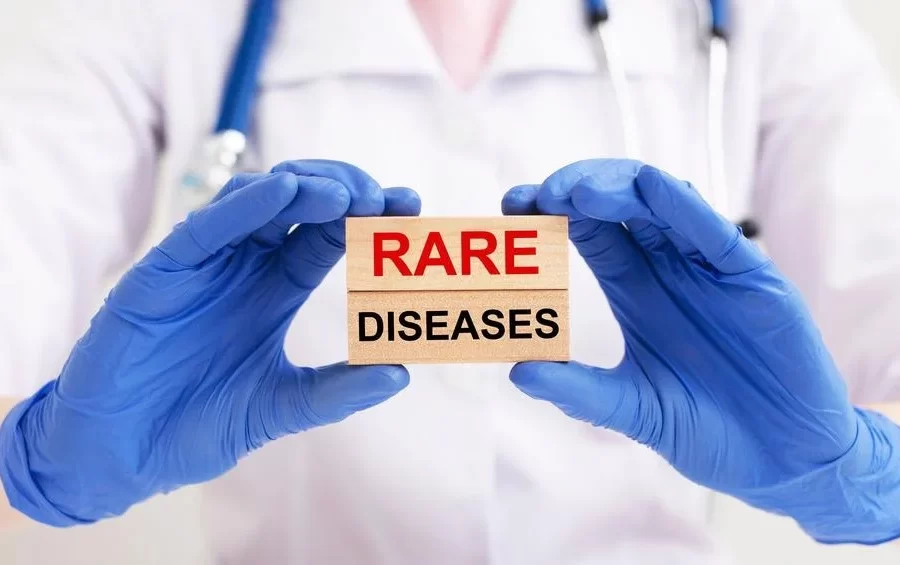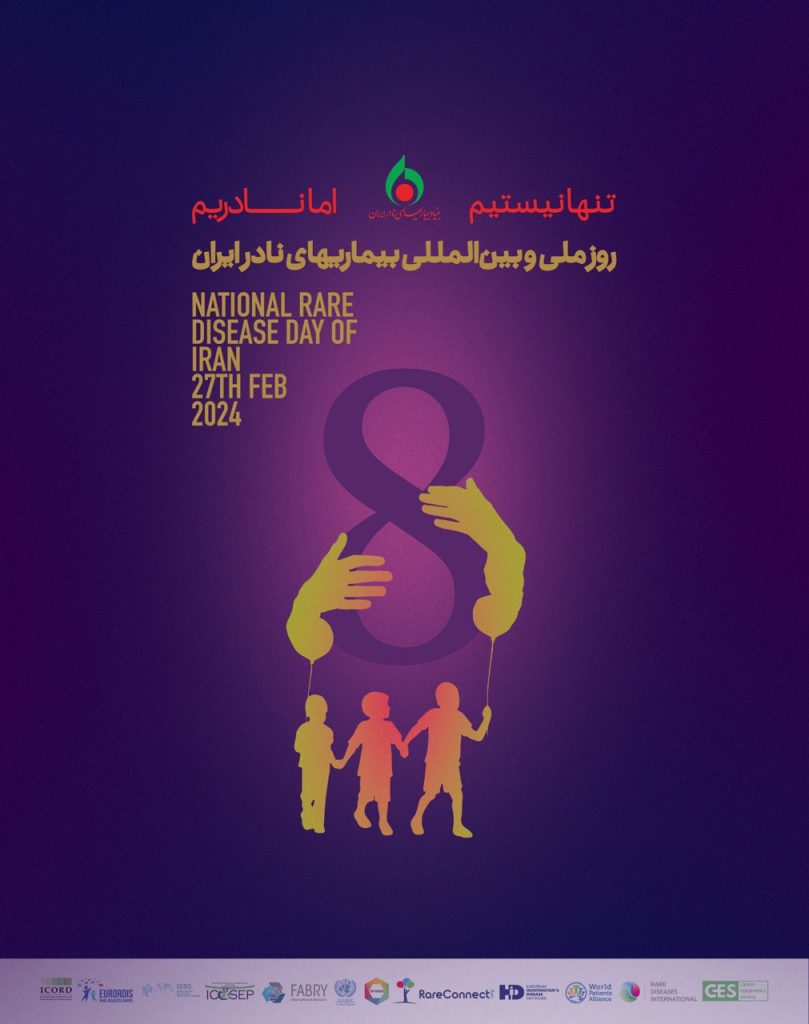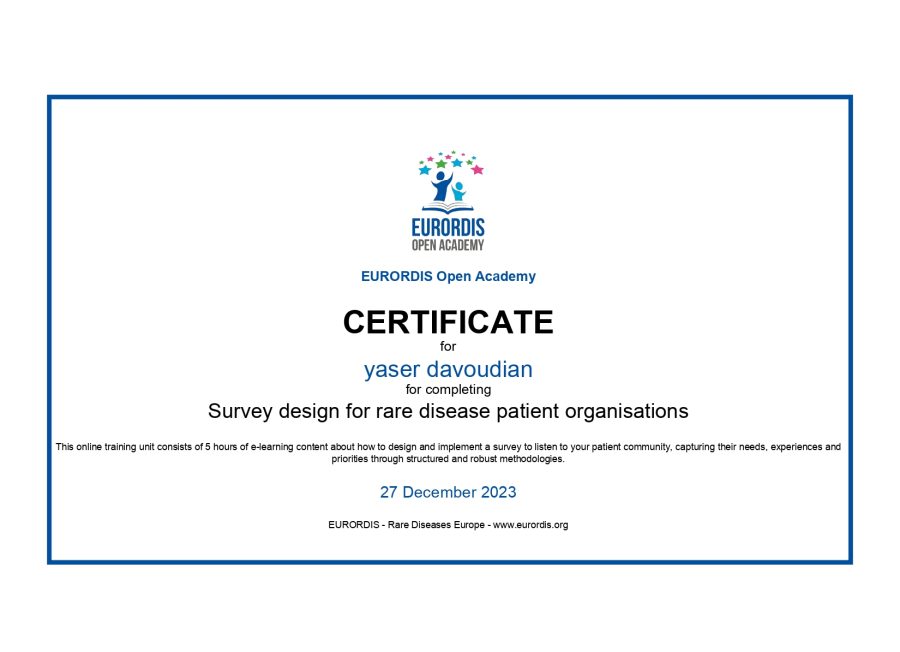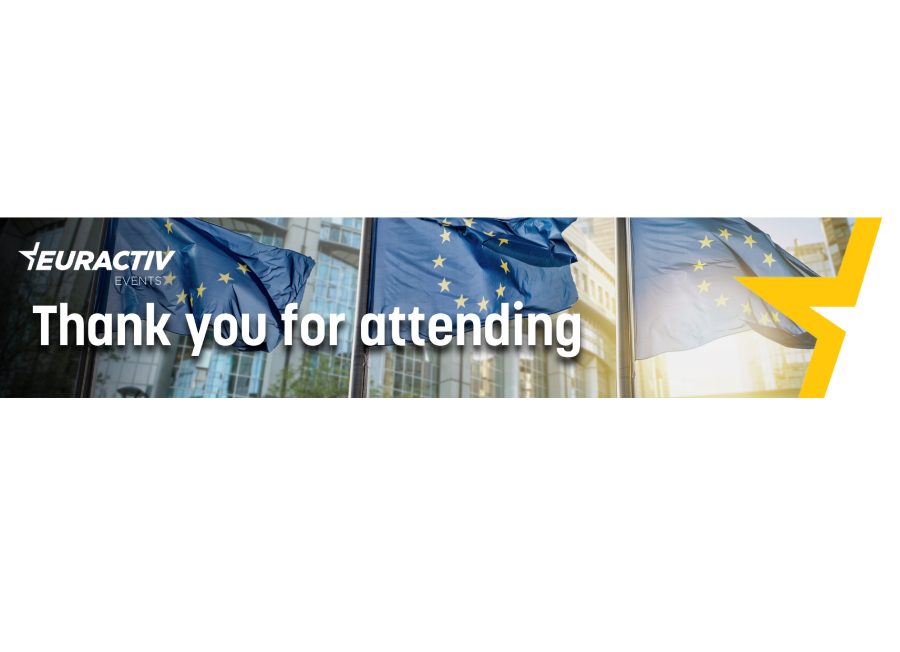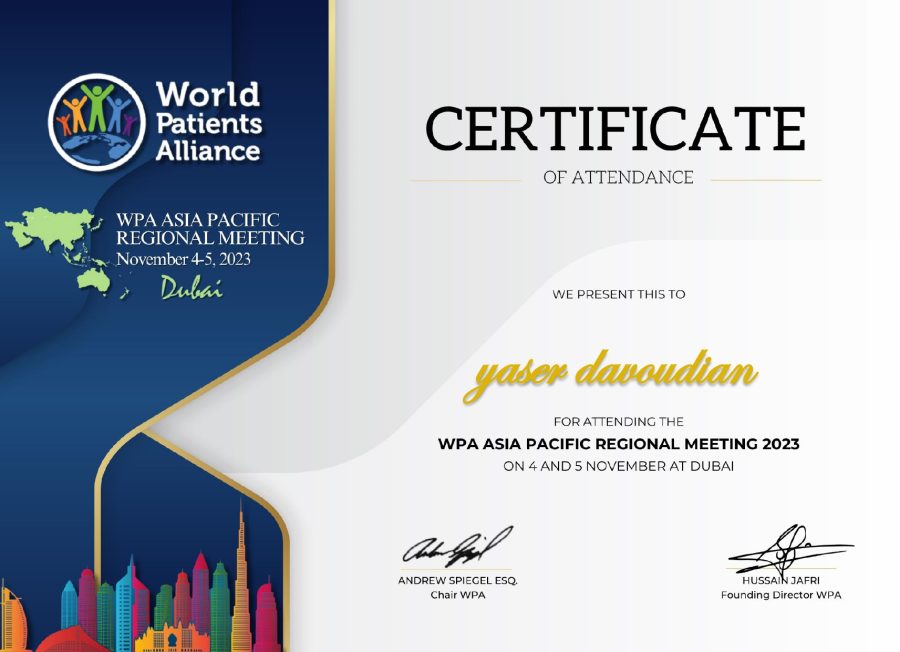The International world patient alliance appointed Yasser daoudian, chief of the board of Directors of the Rare Diseases Foundation of Iran, as a member of the Advisory Board of this organization. This organization is made up of patients and patient advocacy organizations around the world and aims to ensure all patients have access to safe, high quality and affordable healthcare in the world. The union has been trying to present the latest achievements in medical science by holding scientific seminars and conferences. It also holds meetings with specialists and leaders of NGOs to access new medical knowledge and uses their experience to improve the conditions of patients in all parts of the world. The rare foundation of Iran hopes that interactions with international societies will reduce the number of patients and rare diseases in the world and provide new treatment facilities for rare patients by updating information about rare diseases and proper communication with the world’s medical societies.
5 Things About Mental Health and Life With Rare Diseases
By Natalie Abbott
May 17, 2023
2 min read
Last updated: November 2023
May is Mental Health Awareness Month. Like many in the rare disease community, maintaining my physical and mental health is ongoing work for me.
Recently, I’ve been working to improve the care I give to my mental health and want to share a few of my current takeaways.
5 thoughts about mental health and rare diseases
Some are quite cliche, but I do find them useful to say (or write) out loud during times when I may face challenging mental and physical circumstances.
We all learn to live with our rare diseases and develop amazing coping mechanisms, but sometimes it’s helpful to step back and look at how our mental and physical health are related.
1. This is hard
Living with health challenges, especially rare diseases that are often misunderstood by medical professionals and the public, is hard! What we go through, both physically and psychologically, shouldn’t be disregarded.
Saying that it’s hard isn’t an admission of not being strong, it’s a sign that you’re working on it. Finding allies, either within my rare disease community or outside of it with people who are understanding of the mental and physical health challenges of a rare disease, has changed my rare disease life.
2. Embrace your own coping mechanisms
Honestly, I’ve never understood the literal spoon theory (Why do we start out with so many spoons in the first place? Where do they all come from?) but the idea of only finite physical or mental energy and prioritizing based on that has been life-changing.
I know how much I can schedule based on how I will probably feel and sticking to that schedule is the best way to preserve my physical, and thus my mental, health. Don’t be afraid to share your energy-conservation strategies with others! Once people know you aren’t purposefully cancelling on them, it’s so much easier to schedule (and re-schedule) things that work for your body.
3. Practice self-care (really), whatever that is
I know, I know – self-care is the buzziest of buzzwords in our current world but finding what self-care is for you, in all its potential forms, is so powerful.
For me, self-care can look different depending on how I feel, what I can do, and what else is going on. It’s everything from the proverbial walk with the dog to a meditation app to binge watching mindless but soothing television shows. Finding and sticking to even a changing routine is so valuable.
This or That
Self-care is…
Top of Form
Something I intentionally practiceSomething I haven’t really thought about
Bottom of Form
4. Don’t be afraid to reach out
Once again, this can’t be said enough. Mental health resources are out there and can be so useful. From self-guided programs to individual or group sessions, in person or online, seeking help is never a sign of weakness or an admission that something is “wrong” it’s just another tool to help navigate this rare disease life.
5. It’s okay not to be okay
If you are here it’s probably because you, or someone you are close to has a rare disease. It is totally okay and normal to have mental health challenges with our rare disease health issues, and to have those challenges change over time!
It’s not a reflection on your coping abilities or strength to suddenly have challenges with things you’ve always faced. It just is, and that’s okay.
What is a Rare Disease?
- By Dr. Priyom Bose, Ph.D.Reviewed by Emily Henderson, B.Sc.
Any unusual life-altering complication of the human body affecting a small number of people is classified as a rare disease (RD). These diseases are complex and possess a significant challenge both in terms of diagnosis and management. The field of rare diseases is constantly evolving.
A plethora of rare conditions are constantly being added to the already existing pool of rare complications. Due to this, clinicians and researchers across the globe are working tirelessly to create better management and therapeutic approaches for the patients.
Image Credit: valiantsin suprunovich/Shutterstock.com
Rare Disease (Looking Deeper)
Compared to the innumerable number of patients affected by prevalent diseases like diabetes, heart diseases, etc., a rare disease has a limited number of patients. So far, about 5000-8000 unique, rare diseases have been described. Rare diseases affect approximately 400 to 700 million individuals globally, making them a global healthcare issue.
An RD affects around 60 million individuals in the United States and the European Union. The number of RDs is currently estimated to be in the thousands. These conditions are frequently significant, harm one’s quality of life, and can even be fatal. Most RDs have a genetic component, with 72–80 % of these disorders having a gene or genes identified.
They are usually defined by their low frequency, measured in terms of prevalence or incidence within a country or geographical region. In the medical literature, five novels RDs are characterized on average every week. According to a global study of RD terminology, 58% of definitions contained a prevalence criterion, with a global average of 40 cases per 100,000 persons.
According to the European Medicines Agency or EMA, rare diseases can be described as a medical condition with a prevalence of fewer than 5 patients in 10,000 people. The research and clinical development surrounding rare diseases are escalating at a positive rate. However, there is a lot more to explore and understand.
The Various Challenges
RDs encompass a wide range of disorders and clinical manifestations, however, the vast majority of RDs afflict children and are chronic and life-threatening. The majority of rare diseases aren’t curable, with only a few having efficient available therapies. The recognition and diagnosis of RDs present several interrelated issues. They significantly impact the quality of epidemiologic and clinical investigations and complicate the definition of unmet patient requirements, safety, possible efficacy, effectiveness, and value of RD treatments.
Inadequate awareness and knowledge of RDs can lead to misdiagnosis and a delay in receiving a definitive diagnosis. Patients who are unfamiliar with relevant signs and symptoms may fail to seek medical help when necessary. Similarly, professionals may misdiagnose the disease or mistake symptoms for those of more frequent diseases with which they are more familiar. The comparability of data from epidemiologic and clinical investigations may be significantly limited if we don’t fully grasp the disease and its cause.
Heterogeneity in pathogenesis, presentation of signs and symptoms, disease severity, and development might make it difficult to characterize a rare disease in clinical research and detect it in ordinary clinical practice, leading to misdiagnosis and underestimating of genuine disease frequency.
In patients with pathognomic clinical characteristics, diagnosing an RD may be simple. Diagnostic certainty, on the other hand, might be a challenge due to the variety of many RDs and the difficulty in correctly interpreting sophisticated investigative testing methods.
Biotechnology eBook Compilation of the top interviews, articles, and news in the last year.
Misdiagnoses are widespread as a result of the aforementioned issues, which can lead to ineffective therapy. Such medication may not only cause adverse effects, but it may also hide signs of the underlying problem, delaying the accurate diagnosis and beginning of suitable treatment even longer. An RD’s occurrence varies by geography and country, ranging from dense clustering in certain areas to vast distribution in others. In the situation of prevalence heterogeneity, prevalence statistics from epidemiologic studies undertaken in a specific region may be incorrectly extrapolated to larger geography.
Overcoming the hurdles
Rare disease research has received a great deal of attention in recent decades. It is primarily due to legislation designed to make it easier for patients to have access to effective treatments by rewarding pharmaceutical and biotechnology companies to develop novel medications that would otherwise be unprofitable. In the field of rare diseases, there has also been a remarkable increase in social awareness and worldwide connectedness. Several groups are forming to provide information to the general public and to educate them about uncommon diseases.
As a result, governments all over the world have realized the importance of enacting laws and regulations to encourage the development of new and novel technology for the treatment of RDs. The detection of RDs has improved due to advancements in molecular genetics, disease pathophysiology, and medical technology. They’ve also aided researchers in figuring out how to improve the diagnosis, prognosis, treatment for rare diseases and precisely subclassify common diseases into groups of RDs with different characteristics.
Patient Registries for Rare Diseases: A Goldmine
Patient registries are a valuable instrument in the field of rare diseases (RD) that aids clinical research, promotes the development of appropriate clinical trials, improves patient care, and supports healthcare administration. They create a critical information infrastructure that supports the work of European Reference Networks (ERNs) on rare diseases.
There has been a significant expansion of RD registries in recent years, necessitating the development of guidance for the basic requirements, recommendations, and standards required to maintain a high-quality registry. Several such registries have been formed in recent years including, the Registry for Neuromuscular Disease, Central Registry of Rare Diseases (CRRD), Ataxia-Telangiectasia International Registry, EHDN: registry of juvenile Huntington’s disease, and EUROCARE CF: European cystic fibrosis registry.
The Rare Diseases Registry Program (RaDaR) website was developed in 2021 by NCATS to give the rare disease community free and easily available instructions on how to set up and manage high-quality registries. RaDaR will be a dynamic website. In a staged approach, NCATS staff will continue to add new instructions, best practices, testimonials, and other resources from the rare disease community to the site. Although the researchers exploring the area of rare diseases have achieved significantly, we still have a long road ahead of us.
References:
- Navarrete-Opazo, A. A., Singh, M., Tisdale, A., Cutillo, C. M., & Garrison, S. R. (2021). Can you hear us now? The impact of health-care utilization by rare disease patients in the United States. Genetics in medicine: official journal of the American College of Medical Genetics, 23(11), 2194–2201. https://doi.org/10.1038/s41436-021-01241-7
- Nestler-Parr, S., Korchagina, D., Toumi, M., Pashos, C. L., Blanchette, C., Molsen, E., Morel, T., Simoens, S., Kaló, Z., Gatermann, R., & Redekop, W. (2018). Challenges in Research and Health Technology Assessment of Rare Disease Technologies: Report of the ISPOR Rare Disease Special Interest Group. Value in health: the journal of the International Society for Pharmacoeconomics and Outcomes Research, 21(5), 493–500. https://doi.org/10.1016/j.jval.2018.03.004
- Kodra, Y., Weinbach, J., Posada-de-la-Paz, M., Coi, A., Lemonnier, S. L., van Enckevort, D., Roos, M., Jacobsen, A., Cornet, R., Ahmed, S. F., Bros-Facer, V., Popa, V., Van Meel, M., Renault, D., von Gizycki, R., Santoro, M., Landais, P., Torreri, P., Carta, C., Mascalzoni, D., … Taruscio, D. (2018). Recommendations for Improving the Quality of Rare Disease Registries. International journal of environmental research and public health, 15(8), 1644. https://doi.org/10.3390/ijerph15081644
- Richter, T., Nestler-Parr, S., Babela, R., Khan, Z. M., Tesoro, T., Molsen, E., Hughes, D. A., & International Society for Pharmacoeconomics and Outcomes Research Rare Disease Special Interest Group (2015). Rare Disease Terminology and Definitions-A Systematic Global Review: Report of the ISPOR Rare Disease Special Interest Group. Value in healt : the journal of the International Society for Pharmacoeconomics and Outcomes Research, 18(6), 906–914. https://doi.org/10.1016/j.jval.2015.05.008
- Griggs, R. C., Batshaw, M., Dunkle, M., Gopal-Srivastava, R., Kaye, E., Krischer, J., Nguyen, T., Paulus, K., Merkel, P. A., & Rare Diseases Clinical Research Network (2009). Clinical research for rare disease: opportunities, challenges, and solutions. Molecular genetics and metabolism, 96(1), 20–26. https://doi.org/10.1016/j.ymgme.2008.10.003
- RaDaR. [Online] National Center for Advancing Translational Sciences. Available at: https://ncats.nih.gov/radar
Last Updated: Feb 15, 2022
WPA Asia-Pacific Regional Meeting
4 – 5 November, Dubai, UAE
with attendance of Dr yaser davoudian
The vibrant city of Dubai hosted the highly anticipated Asia-Pacific Regional Meeting of the World Patient Alliance (WPA) on November 4-5, 2023. The gathering brought together global leaders from patient organizations, passionate patient advocates, and dedicated healthcare stakeholders.
A dynamic combination of face-to-face and virtual interaction: One of the outstanding features of the Asia-Pacific Regional Meeting was its hybrid format. This forward-thinking approach allowed participants to connect both in person and virtually, ensuring a diverse and inclusive experience that transcended geographic boundaries. This reflects WPA’s commitment to creating meaningful engagement for a global audience.
Insights from keynote speakers: The event featured a mix of keynote speakers from national and international health organizations, each bringing their unique perspectives to the fore. Insights shared by Mondher Letaief, Shin Ushiro, Lamya Alhazani, Candace Henley, Christiane El Ferzli, Nicole Sheahan, Kimberly Galia, and in-house speakers Andrew Spiegel Esq., Penney Cowan, and Hussain Jafri added depth to the discussions. Overview of key topics: The diverse range of topics covered at the Asia Pacific Regional Meeting provides a comprehensive look at the challenges and opportunities in patient advocacy. From “The Art of Patient Advocacy” to discussions on “Universal Health Coverage” and surveying “Health Emergencies in the Region”, each session contributed to a comprehensive understanding of the current healthcare landscape.
Panel Discussions: Expert Conversation: The event agenda was enriched with panel discussions featuring healthcare experts and patient safety champions. Anas Nofil, Ken Tanda, Edmond Love, Arij Saqer, JS Arora, Mekia Majrashi, Inge Damanti and Regina Kamuga shared their experiences and perspectives, fueling a rich conversation about the future of patient safety and healthcare. Leadership Insights: WPA leadership, including Andrew Spiegel, Penny Cowan, and Hussain Jafari, shared their insights on the success of the event. Their insights highlighted the growing role of patient advocacy in a changing world and expressed appreciation for the global community’s commitment to patient-centered solutions.
A celebration of collaboration and shared dedication: More than just a meeting, the Asia-Pacific Regional Gathering was a celebration of collaboration, dialogue and a shared commitment to improving healthcare for patients worldwide. It provided a fertile ground for making connections, sharing best practices, and exploring solutions that resonate across borders.
The event aims to foster a global dialogue on patient safety, quality healthcare and advocacy. We believe that our active participation will also contribute greatly to your own understanding of the critical issues surrounding patient engagement in healthcare.
How Nature Therapy Helps Me Live Better With a Rare Disease
By Tatiana Corbitt
November 10, 2023
2 min read
Last updated: November 2023
Access to lush, green natural spaces feels like a privilege to me. As a person living with a rare disease, narcolepsy, it isn’t always easy to safely access the outdoors.
However, when I spend time in nature, I feel better – not only emotionally but also physically. Living close to forest trails helps me have an improved life quality as a person living with a rare disease.
Access to medicinal herbs
One of the benefits of local green forest space is access to free medicinal herbs. As a person with a rare disease, treatment options are limited. My rare disease, narcolepsy, isn’t as well understood as other, more common diseases.
My treatment plan has improved over time but has been stagnant for years now since stabilizing. There just aren’t any more pharmaceutical drugs to try for narcolepsy…I’ve tried them all! And my narcolepsy symptoms still disable me, though they are mercifully improved with treatment.
Adding herbal remedies to my narcolepsy treatment plan
I like adding herbal remedies to my treatment plan to help improve my health outcomes. For example, this winter, I’ll be drinking echinacea tea to keep my immune system stimulated and my body healthy through this upcoming cold and flu season. I don’t harvest this herb locally, but it is a goal of mine to learn to (safely) harvest local herbs for similar medicinal uses. It feels empowering to know that I can make small changes in my health or quality of life by doing so.
Be an informed forager
Other natural medicines found in forest spaces include mushrooms and other fungi. Mushroom or plant identification requires a great deal of skill. To safely consume wild mushrooms or plants, you have to know all of the possible local mushrooms and plants, which are edible or not, which are poisonous or not, and which are medicinal. It is difficult to do, but not impossible. This is one skill I hope to gain, so I can benefit even more from the beautiful green forest spaces around me.
Please note that it is important to ask your doctor before starting or stopping treatments, including herbal or fungal medicines, as there are many drug interactions or side effects that can occur.
Access to green space makes me feel better
Overall, I have found that having access to a local forest green space has improved my health in many ways as a person living with a chronic rare disease like narcolepsy.
Hiking allows me to move my body in ways that feel good and increase my stamina and strength. On days when I have more severe symptoms but still want to spend time in nature, I can spend little to no time and effort getting to a trail to see some trees, plants, and birds. And I feel better for it, even if I am still tired afterward.
Do you find nature therapy beneficial for your rare disease? How so? Please share with us in the comments below!
https://raredisease.net/living/nature-therapy
National Strategic Plan for Rare Diseases of Iran
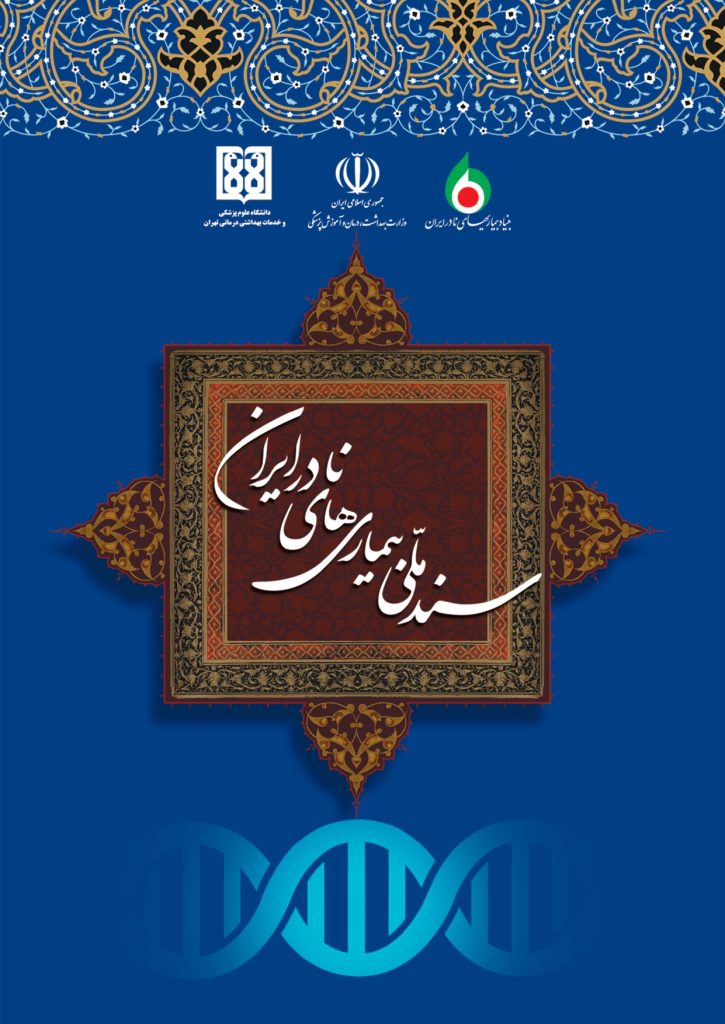
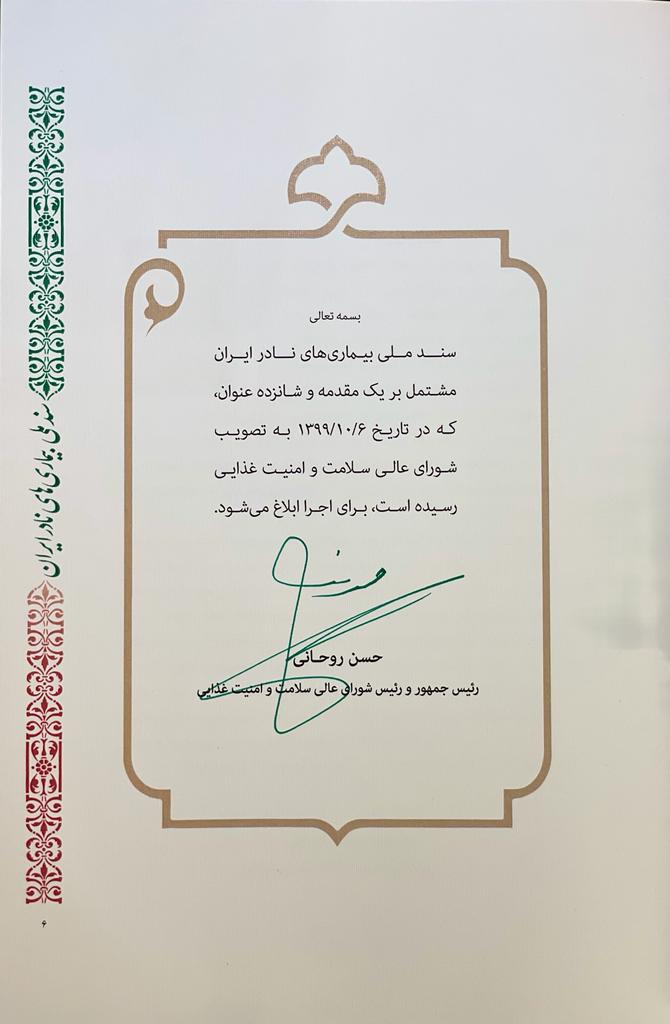
The providing and editing of the national rare diseases document is one of the most vital activities of the Rare Diseases Foundation, and in this regard, the Rare Diseases Foundation of Iran, with a lot of endeavor and follow-up, and with the participation and cooperation of the professors and expertise of the Foundation and other universities of medical sciences, prepared and compiled the National Document of Rare Diseases of Iran, which after being approved by the Secretariat of the Supreme Council of Health and Food Safety and the cooperation and collaboration of the honorable officials of that ministry and other related institutions, was finally approved by the honorable president and announced. Undoubtedly, the declaration of this document can be a very huge and effective step in determining the duties of the institutions and beneficiaries related to these patients, providing services to rare patients and their families, and solving the problems of these patient respectfully

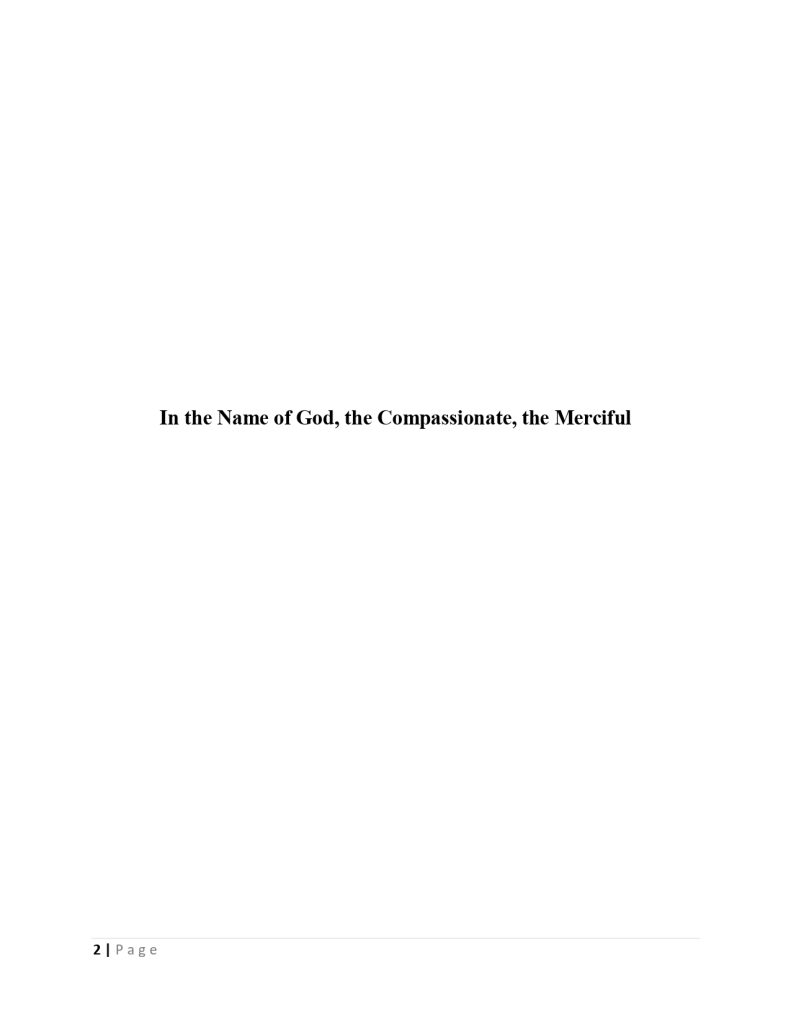
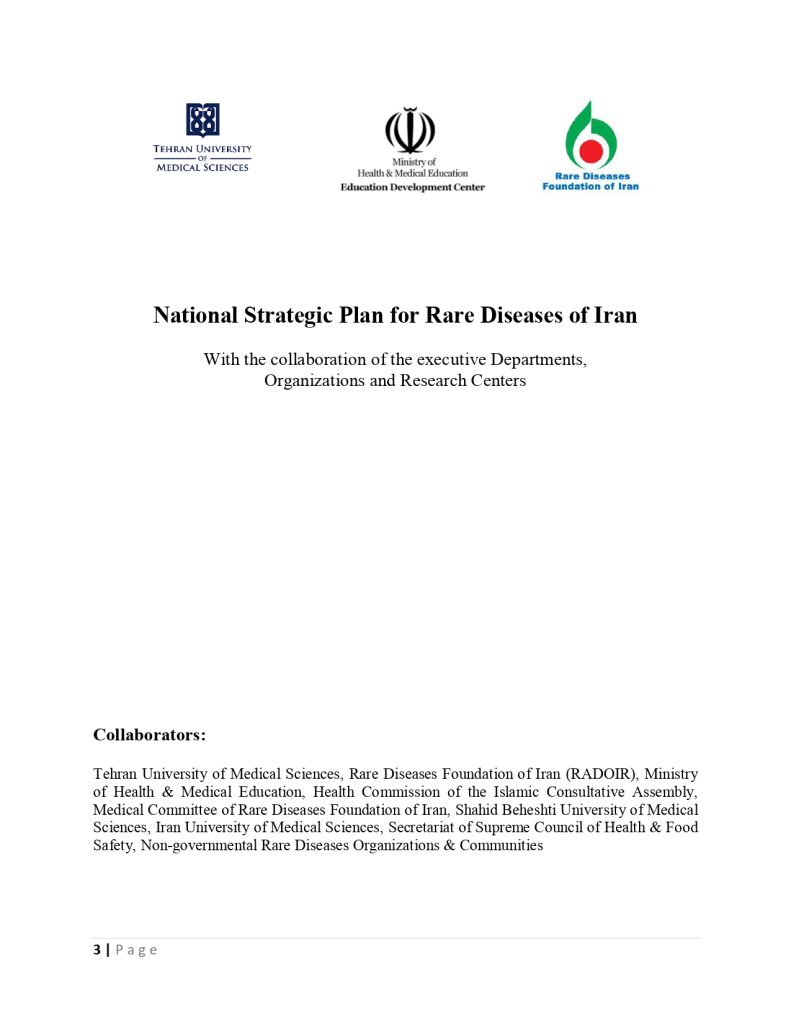
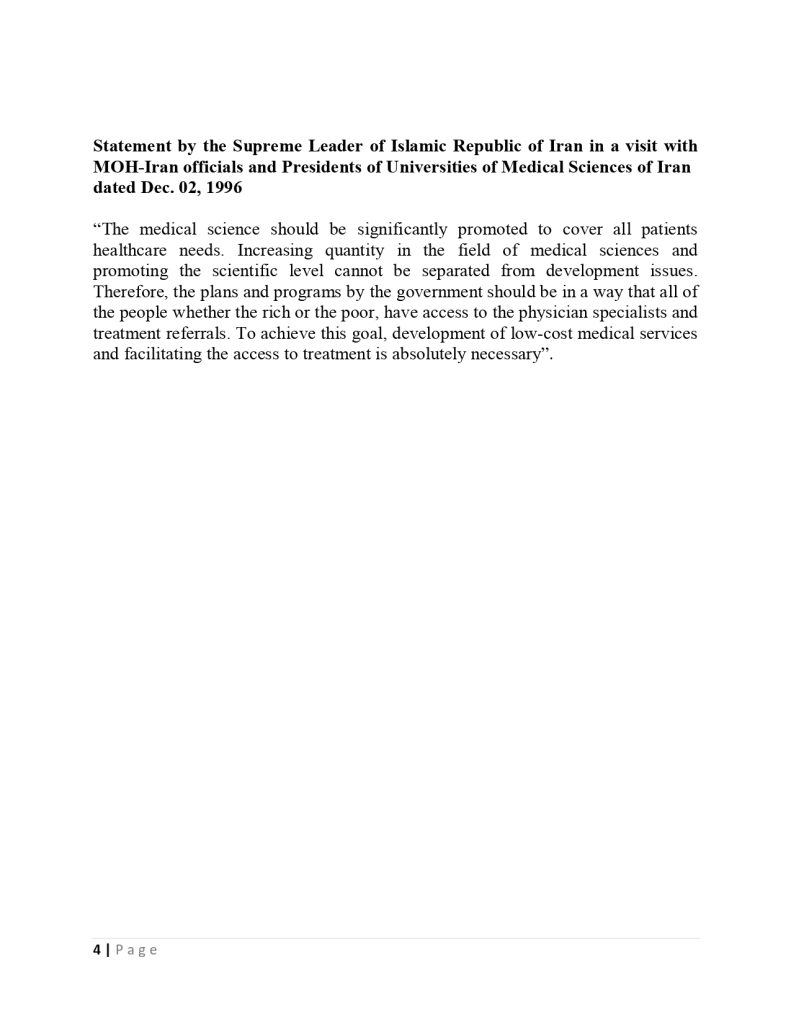
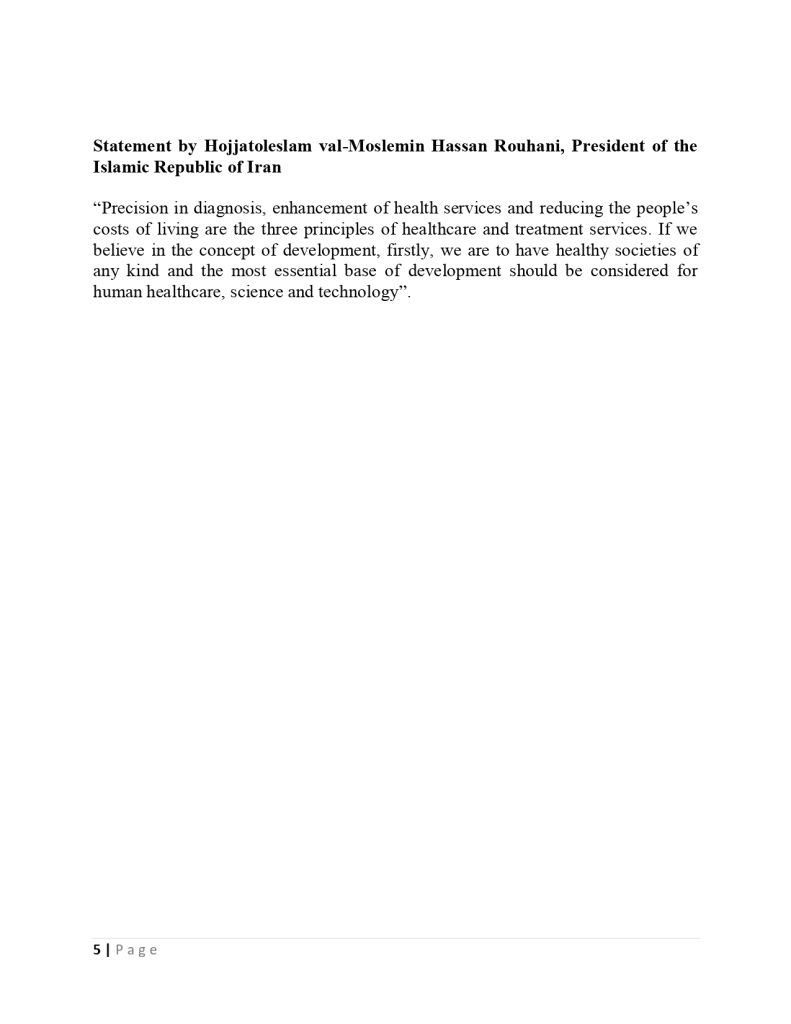
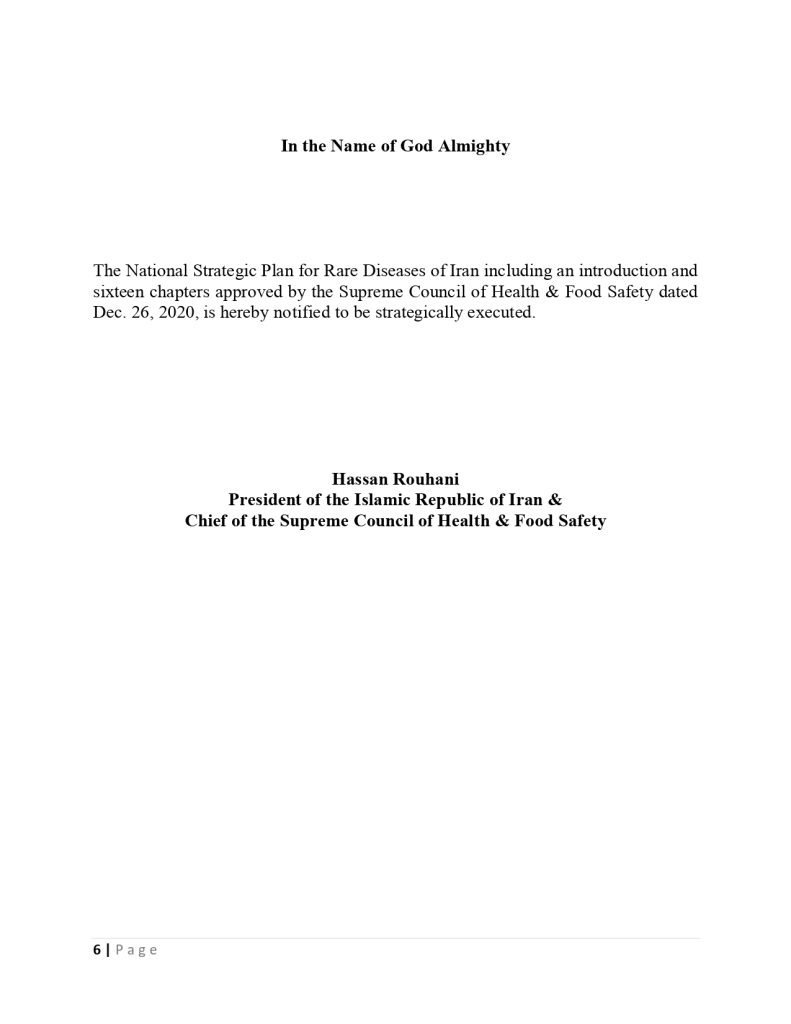
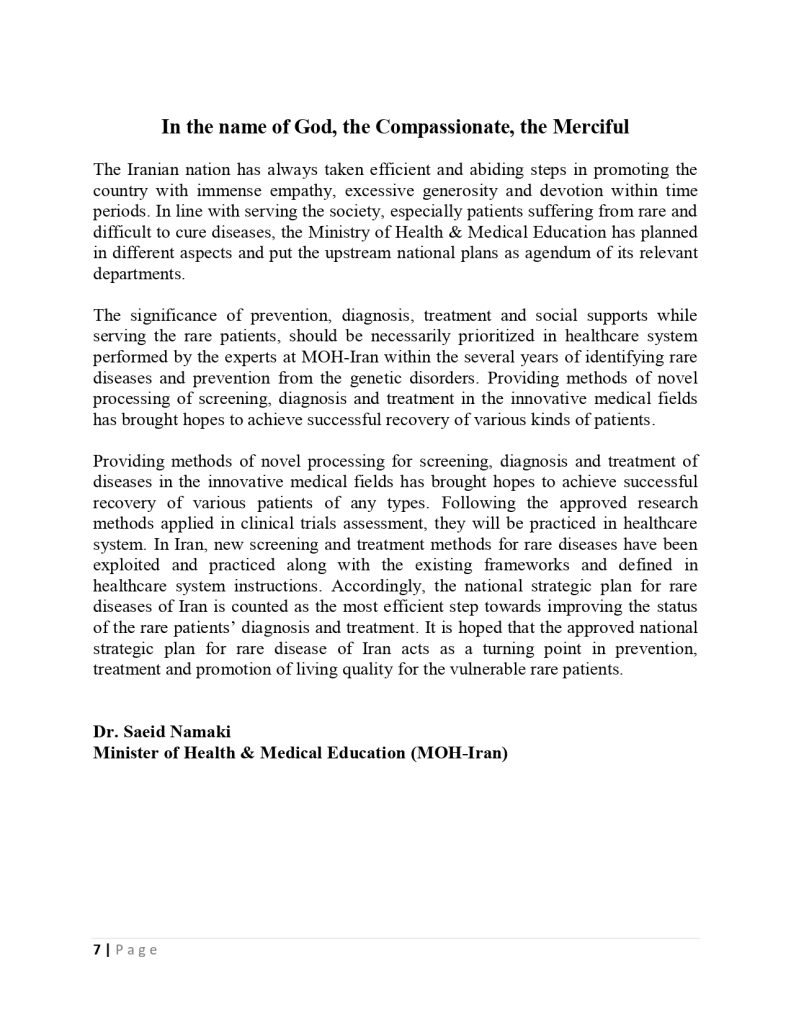
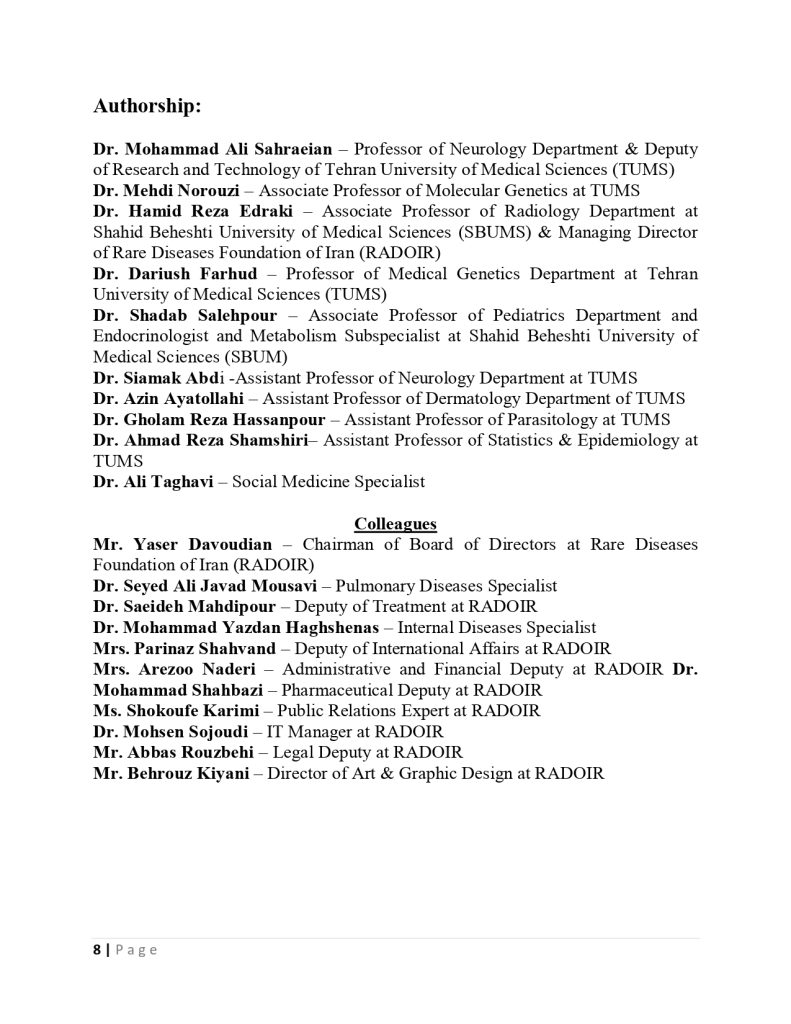
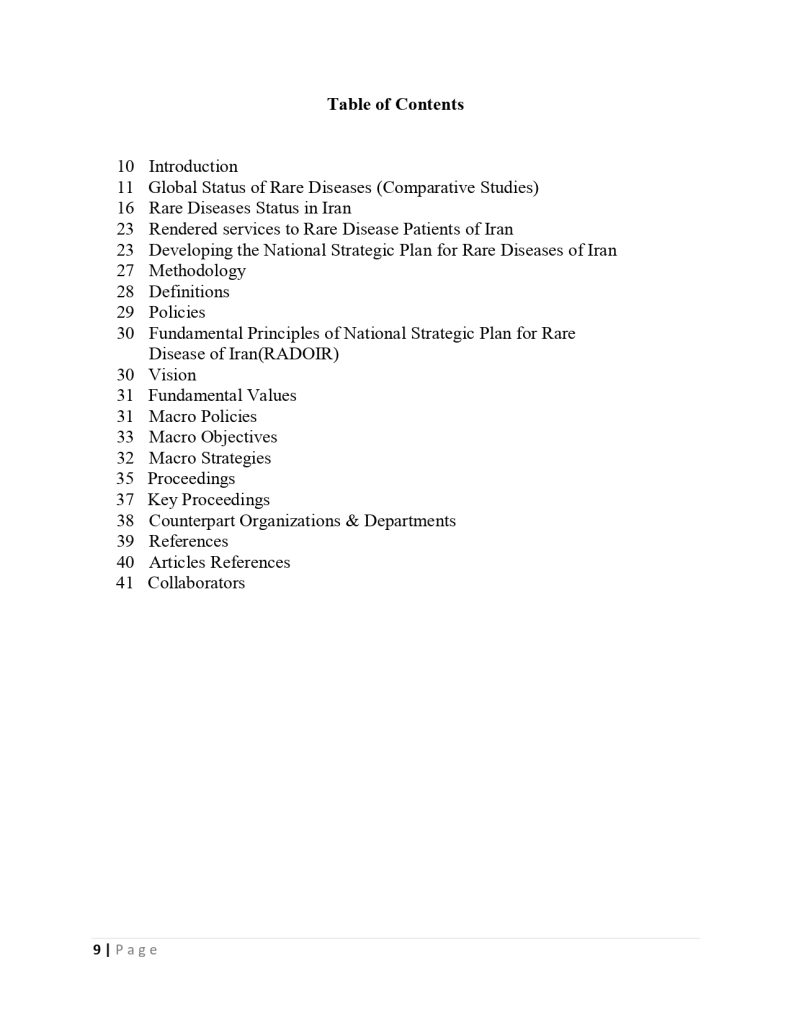
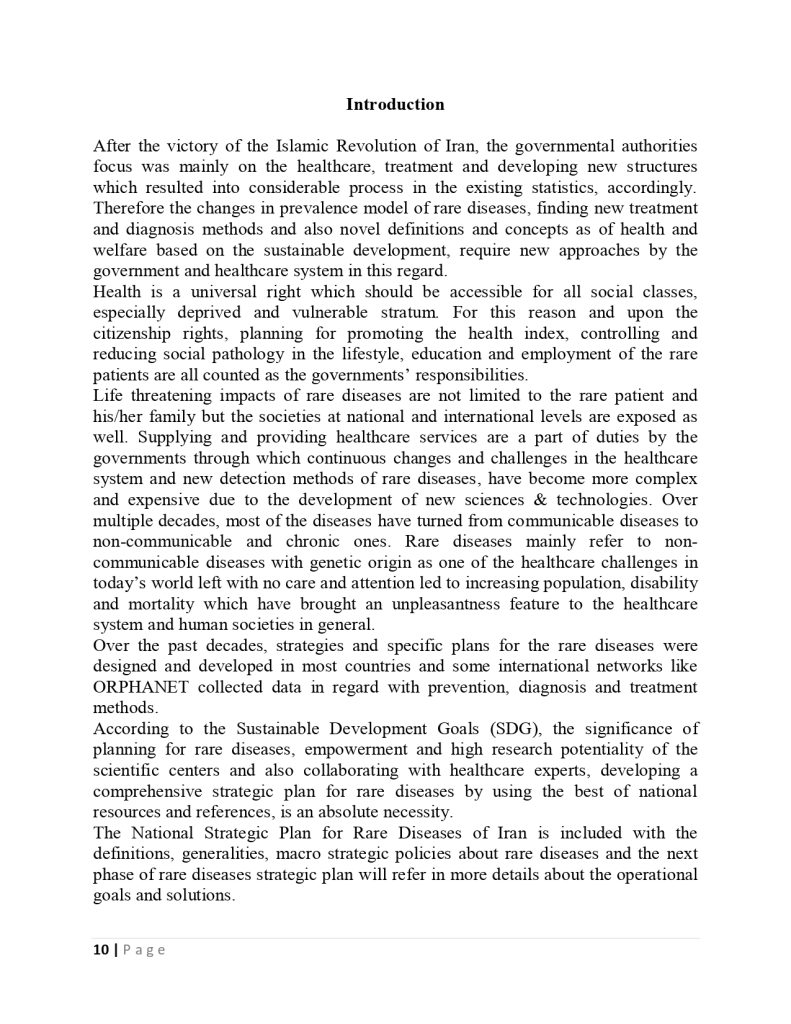
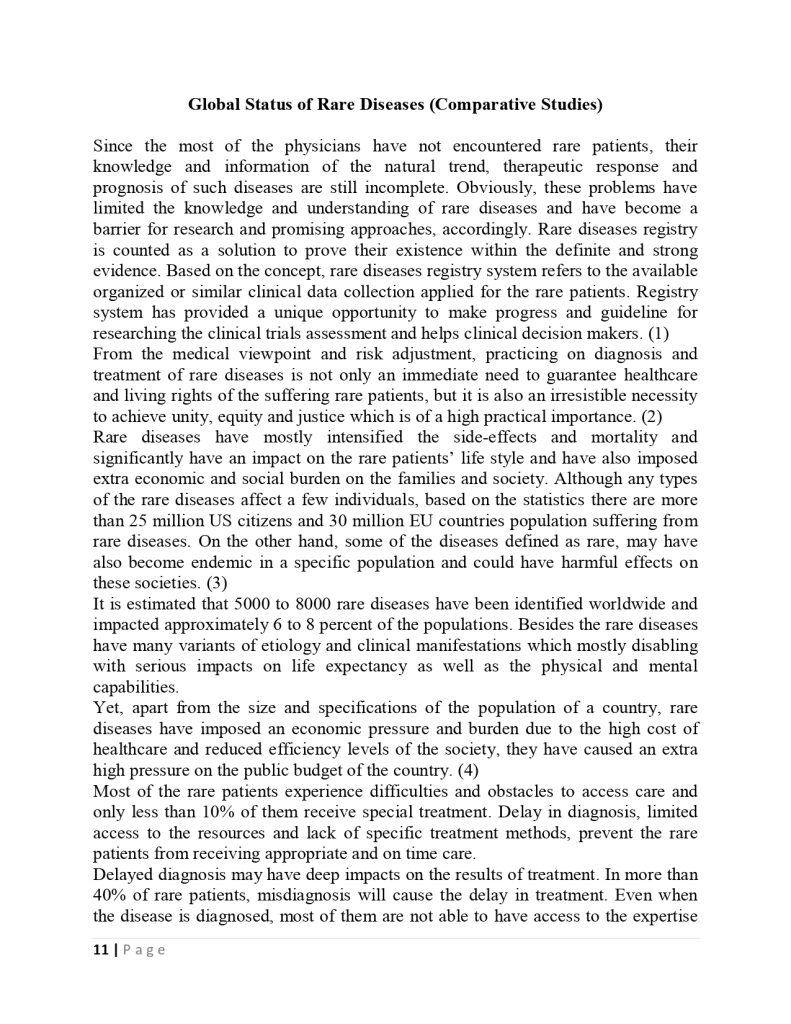
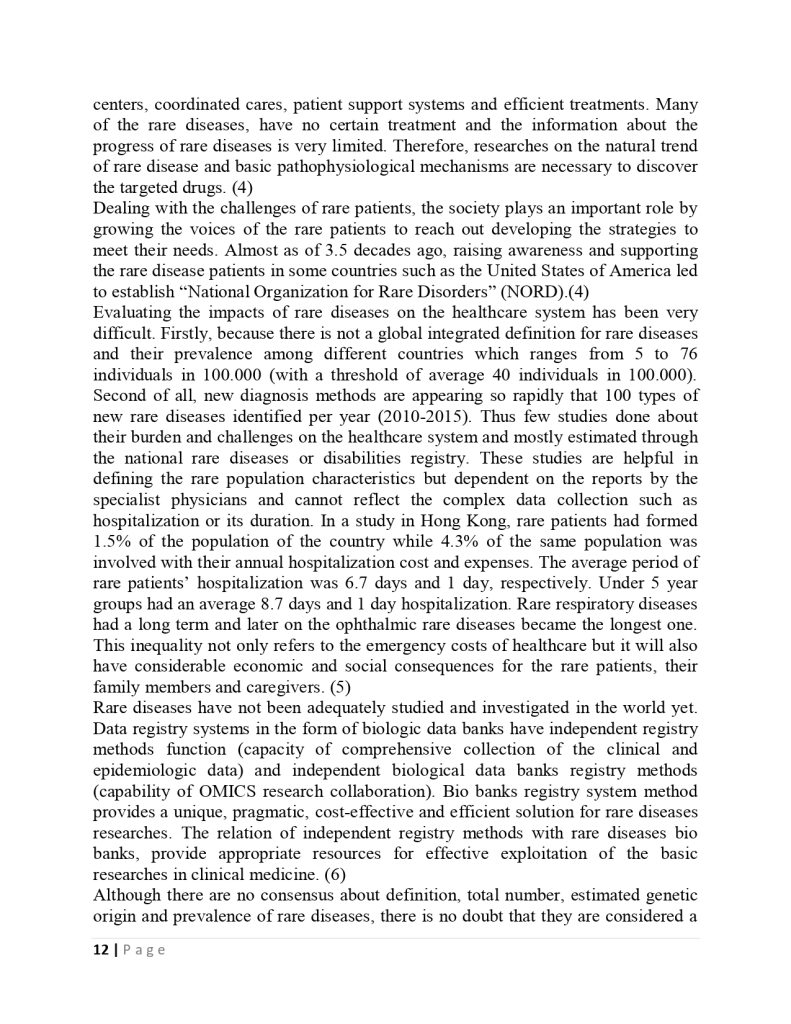
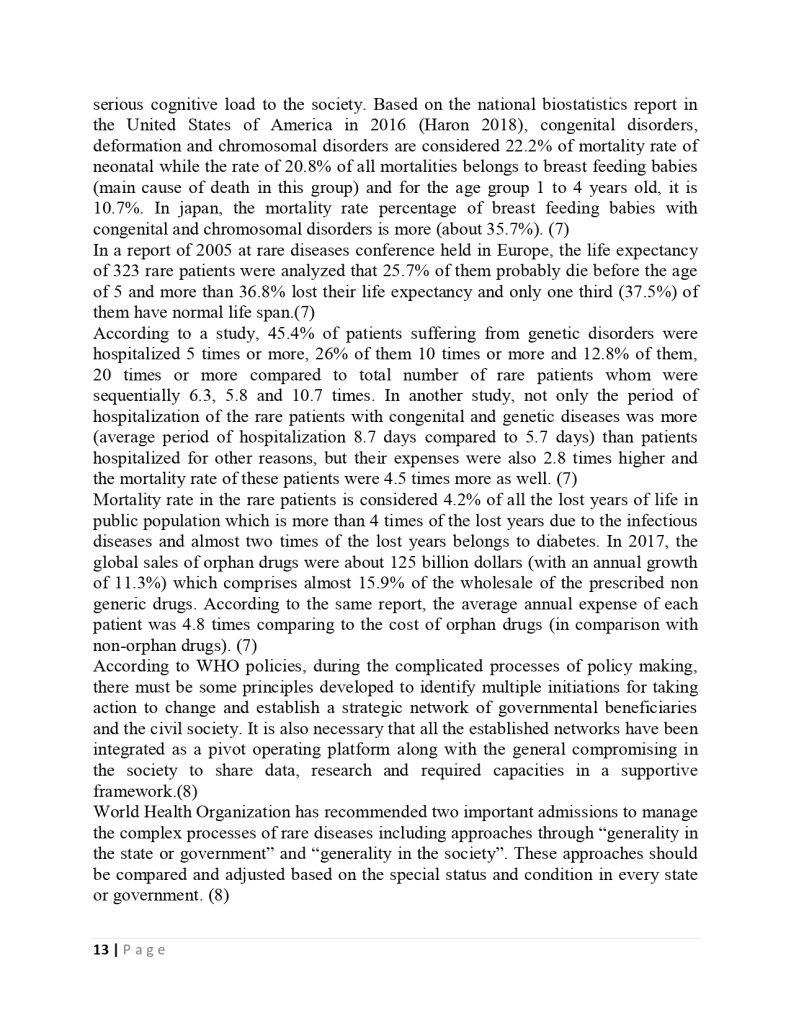
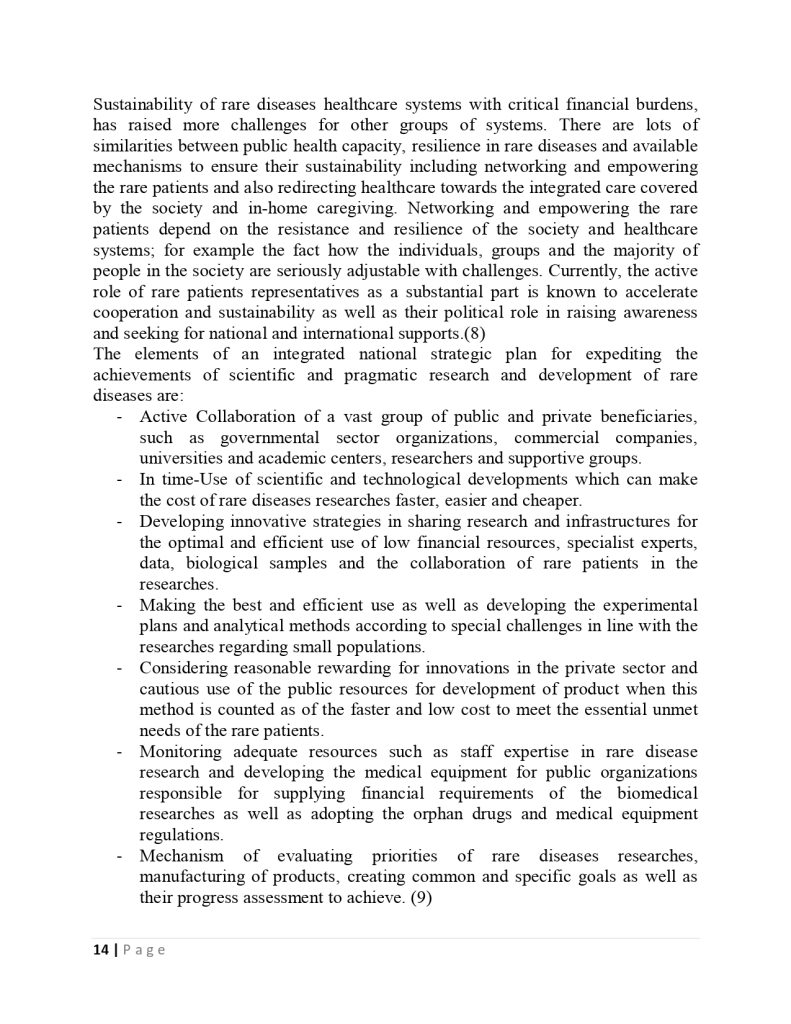
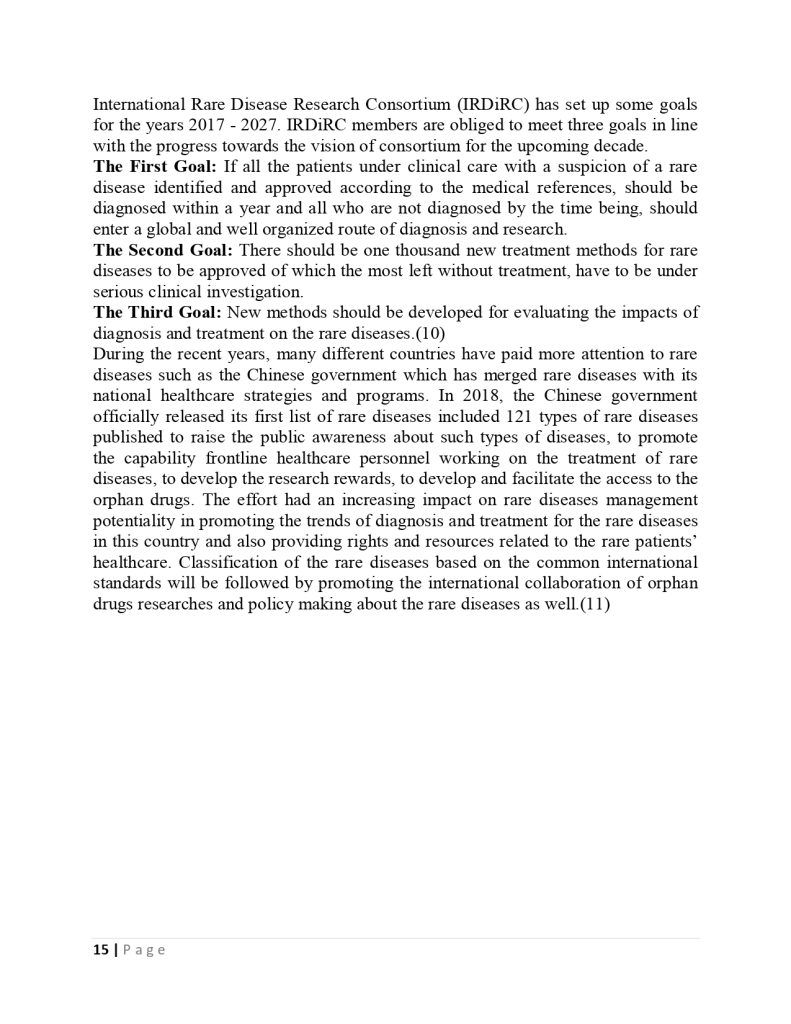
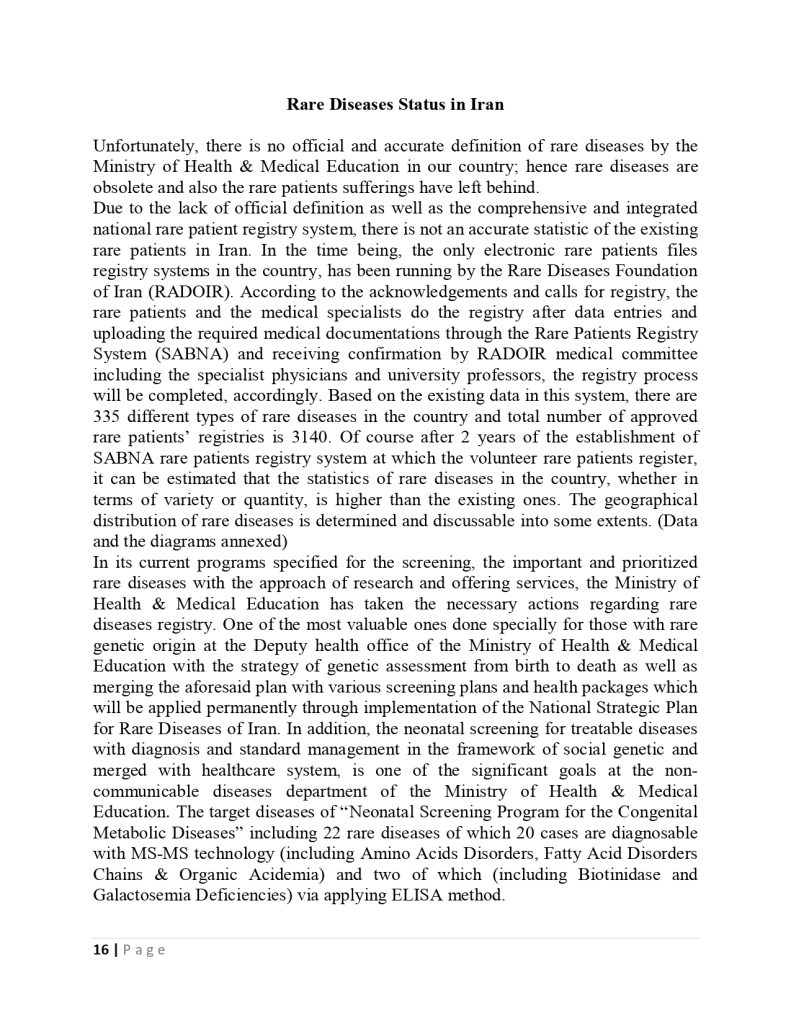
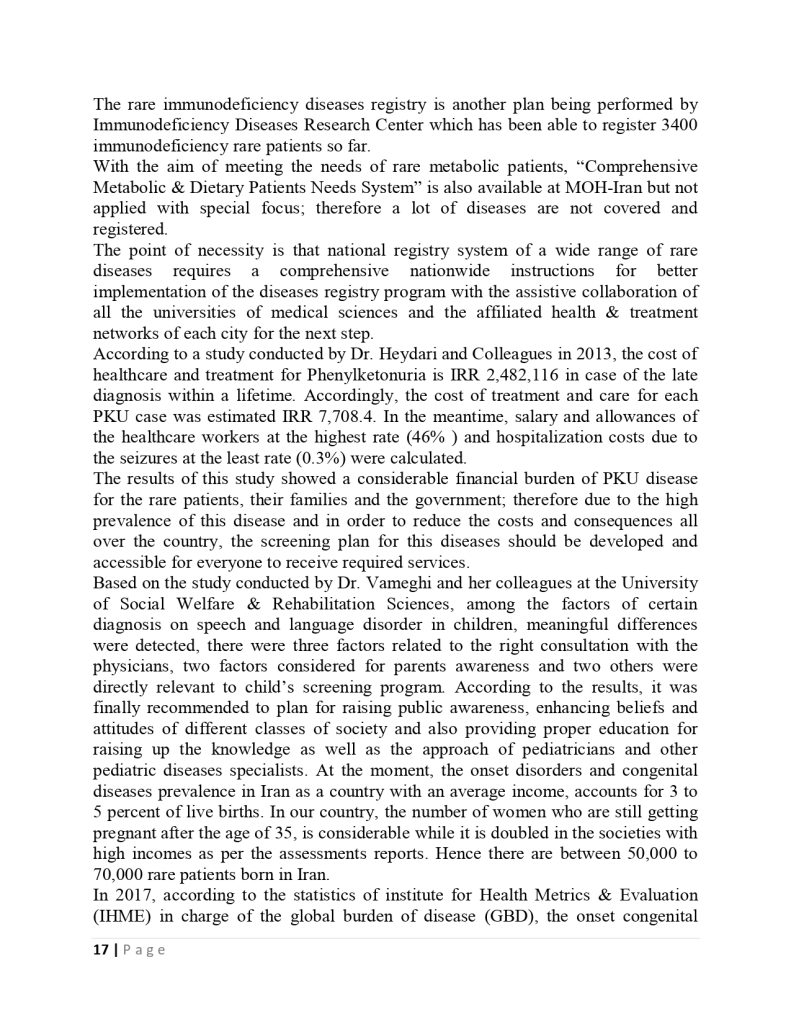
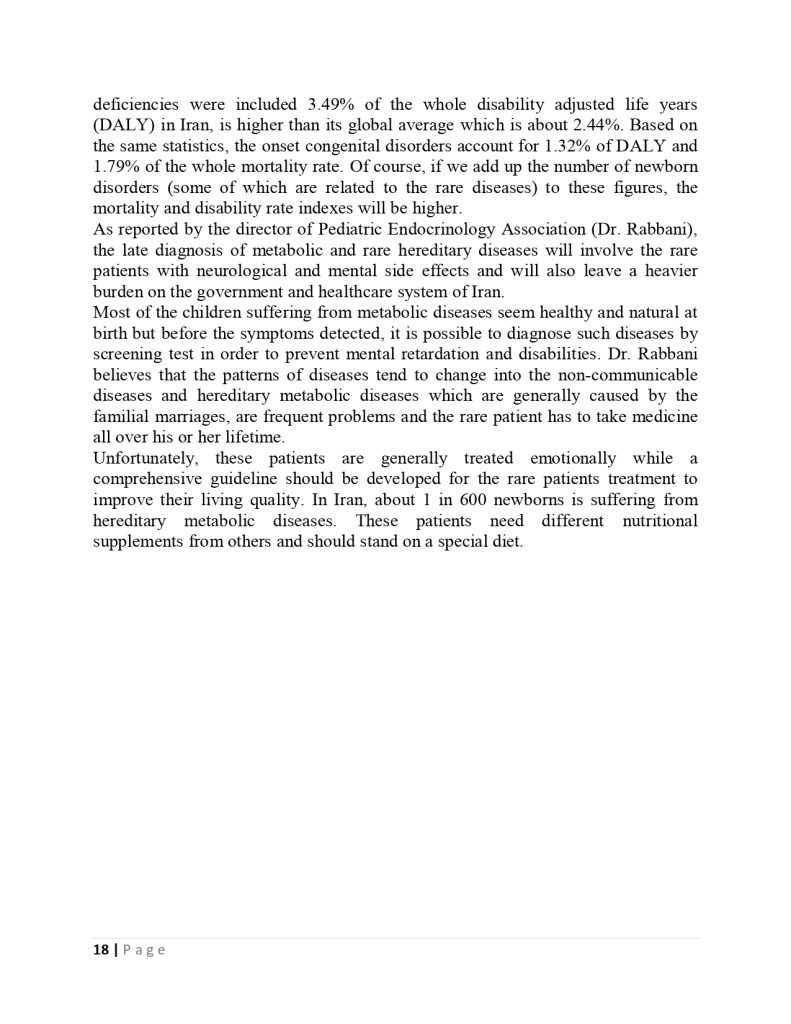

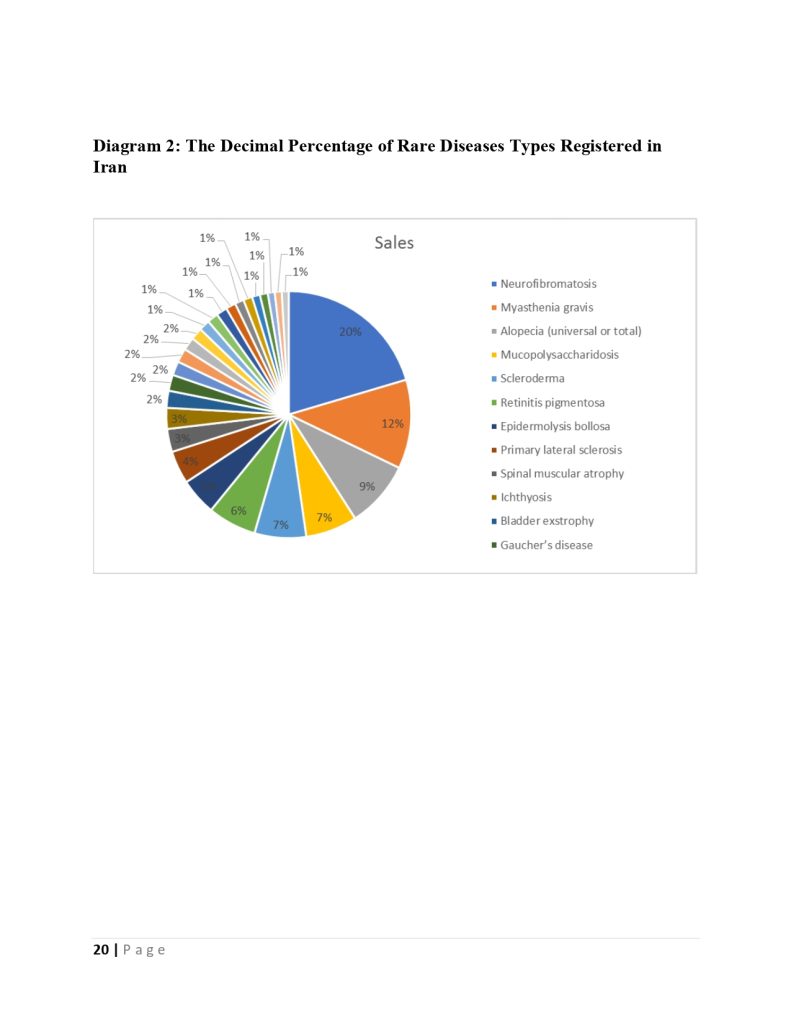
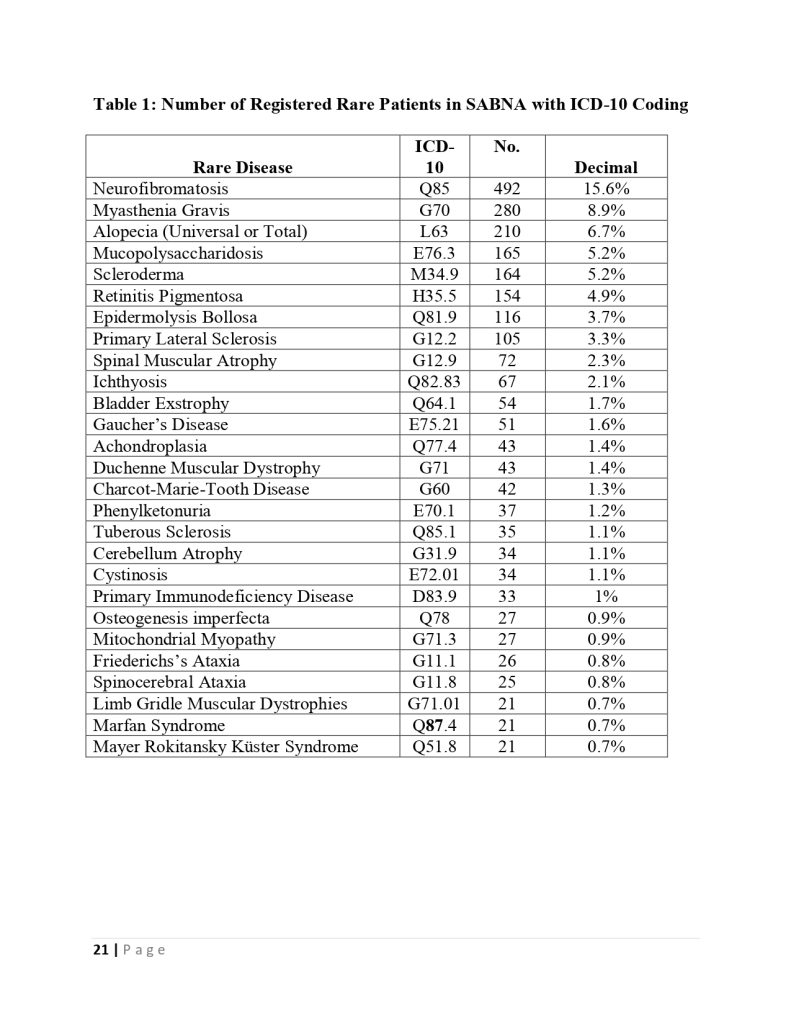
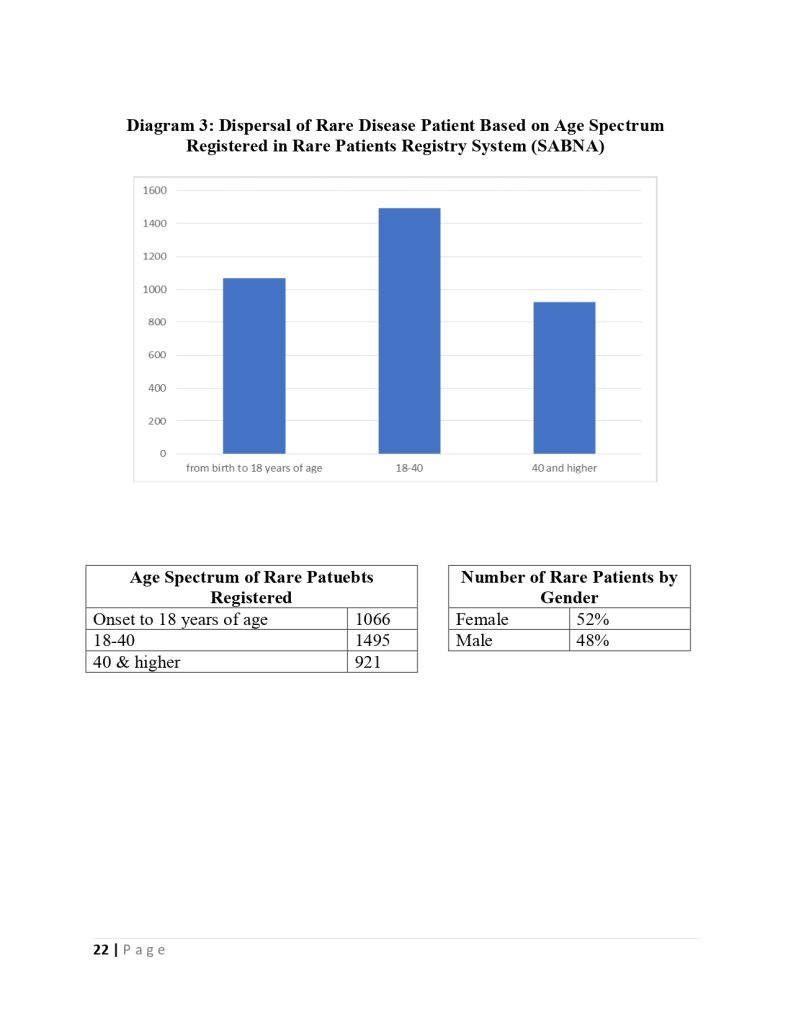
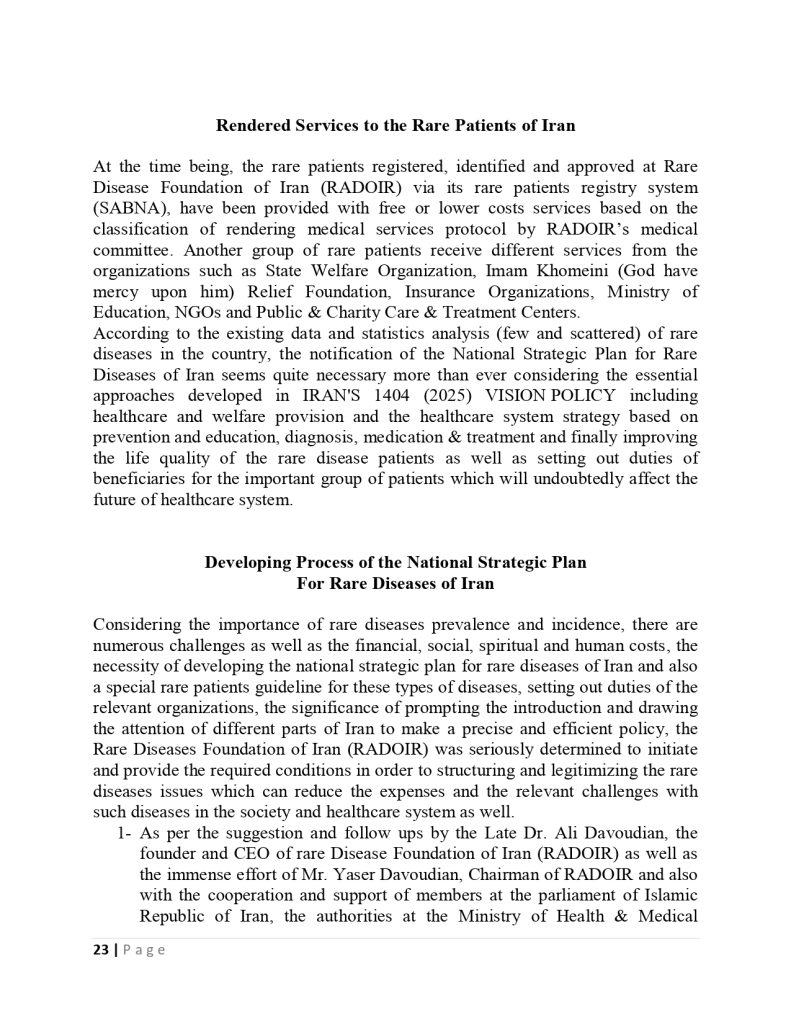
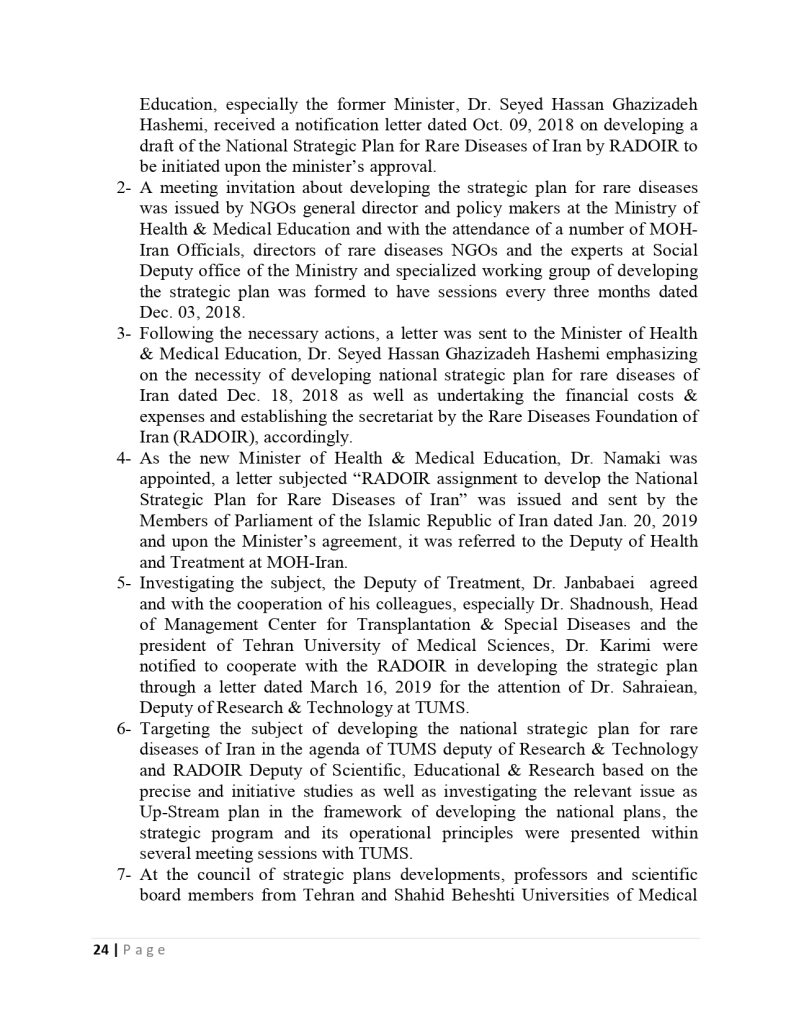
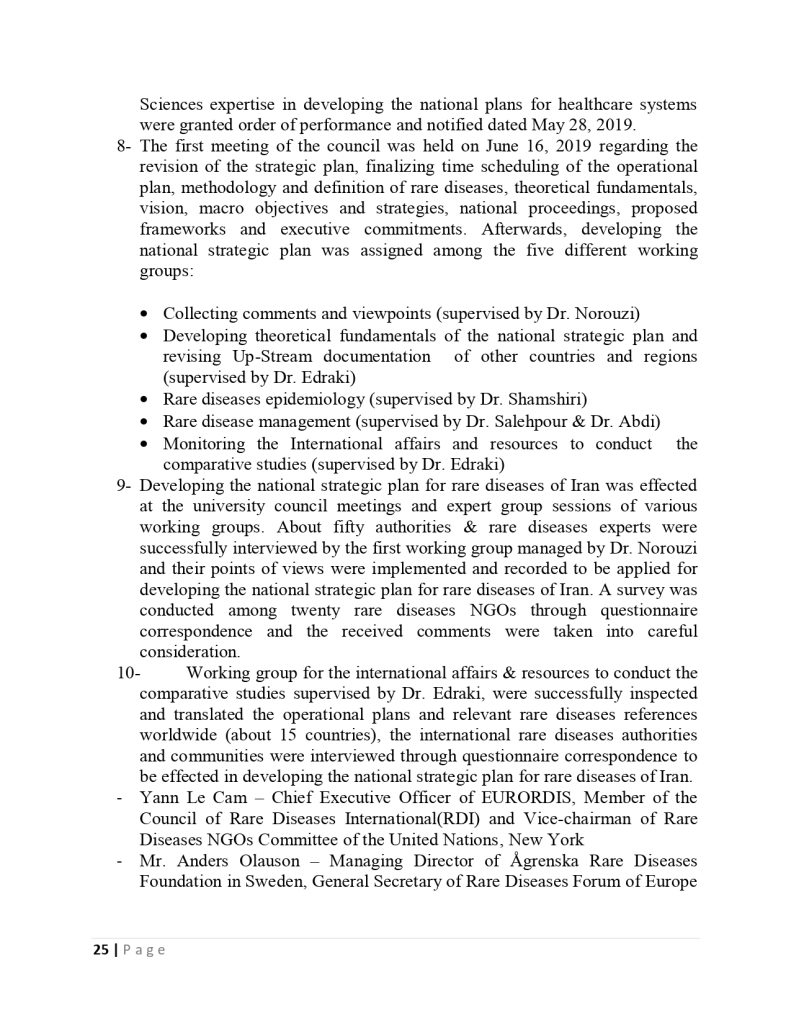
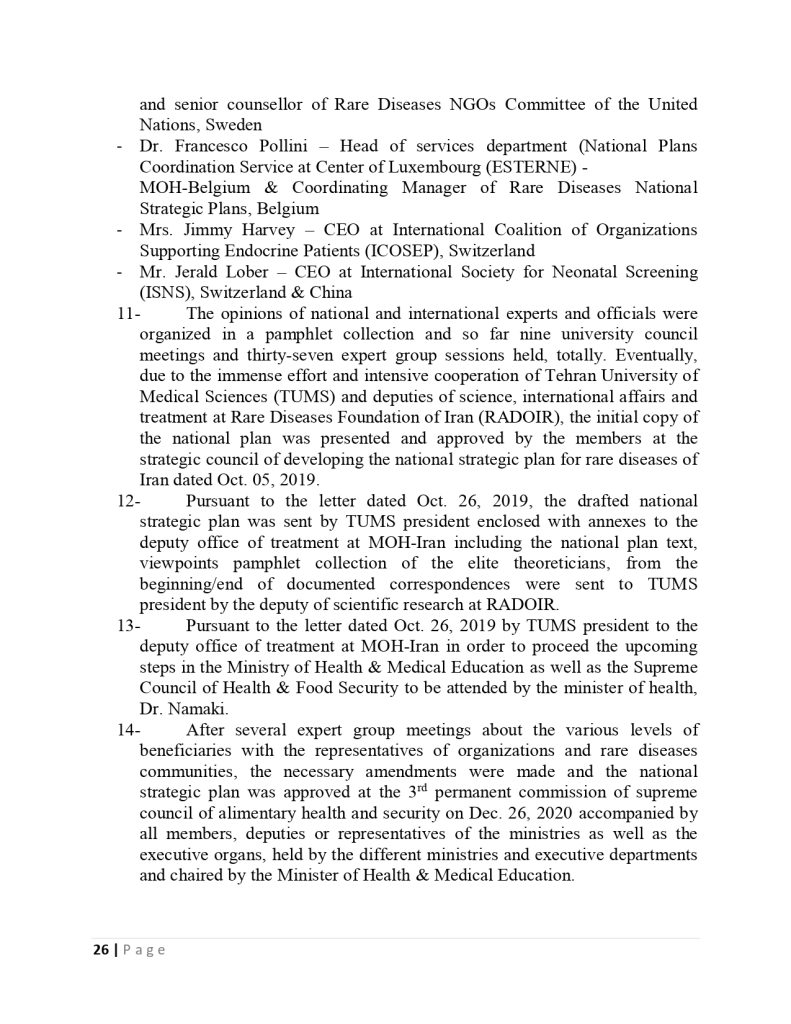

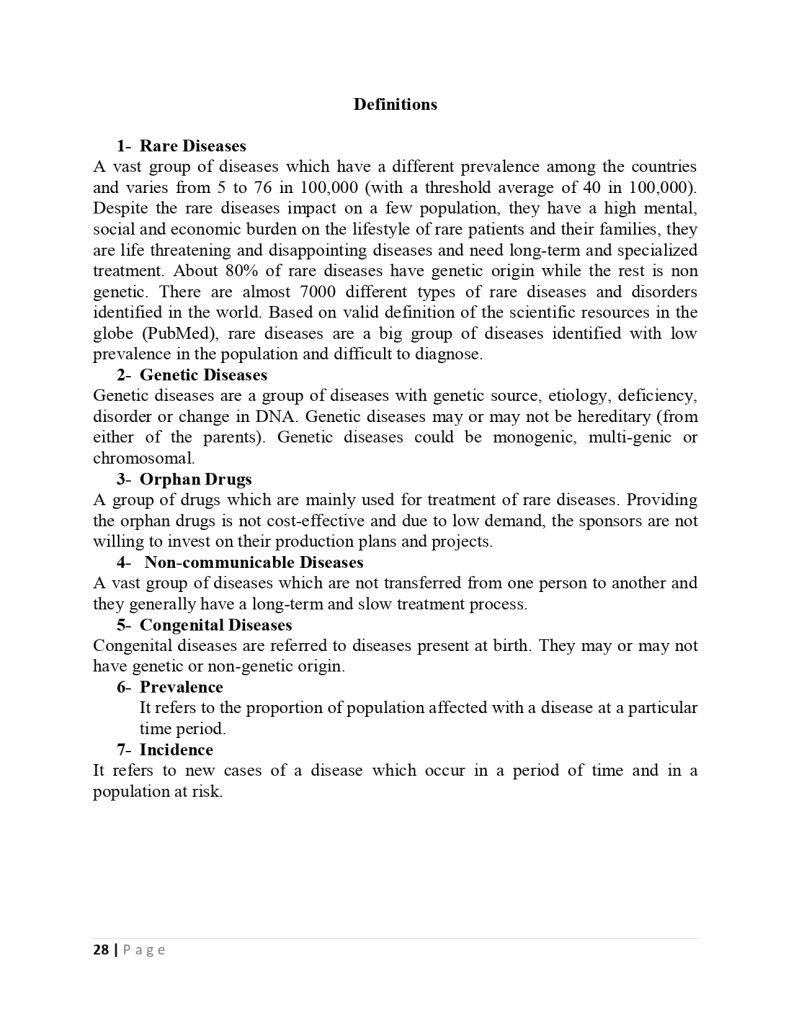

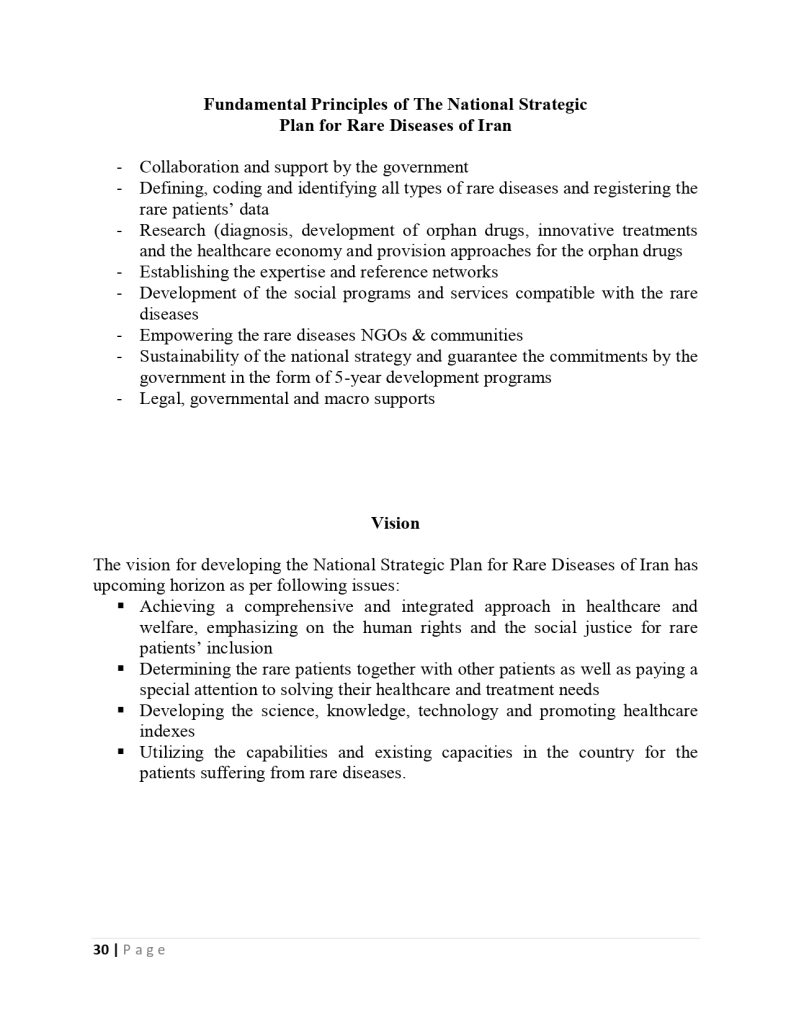
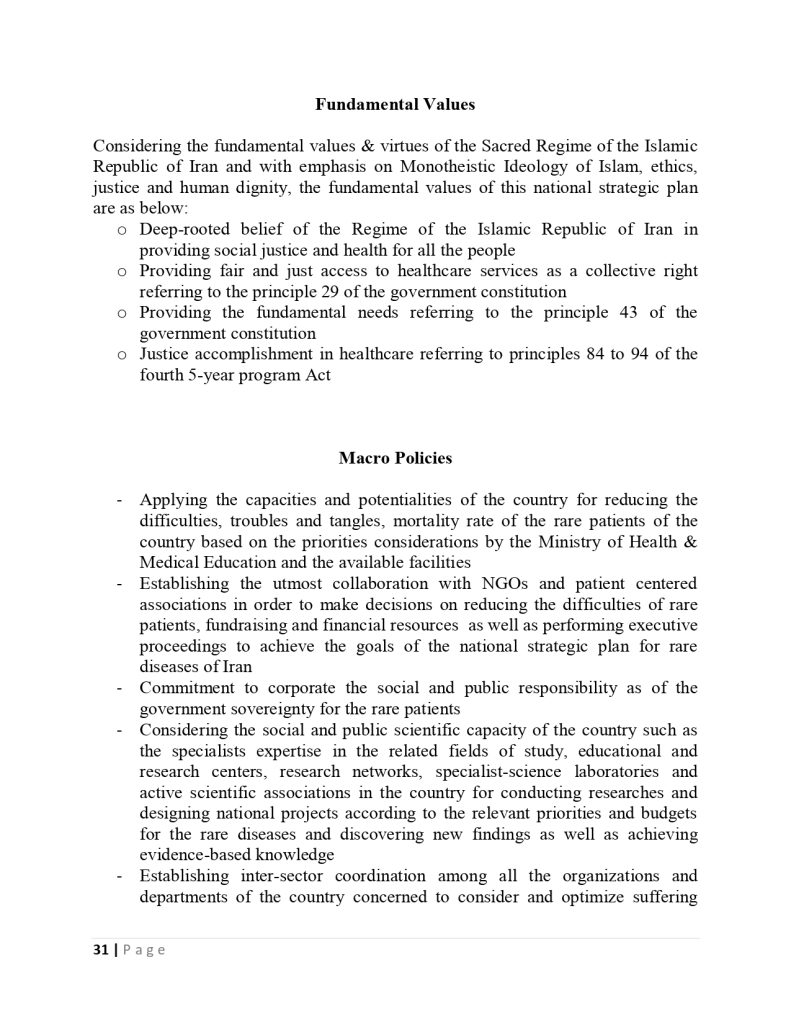
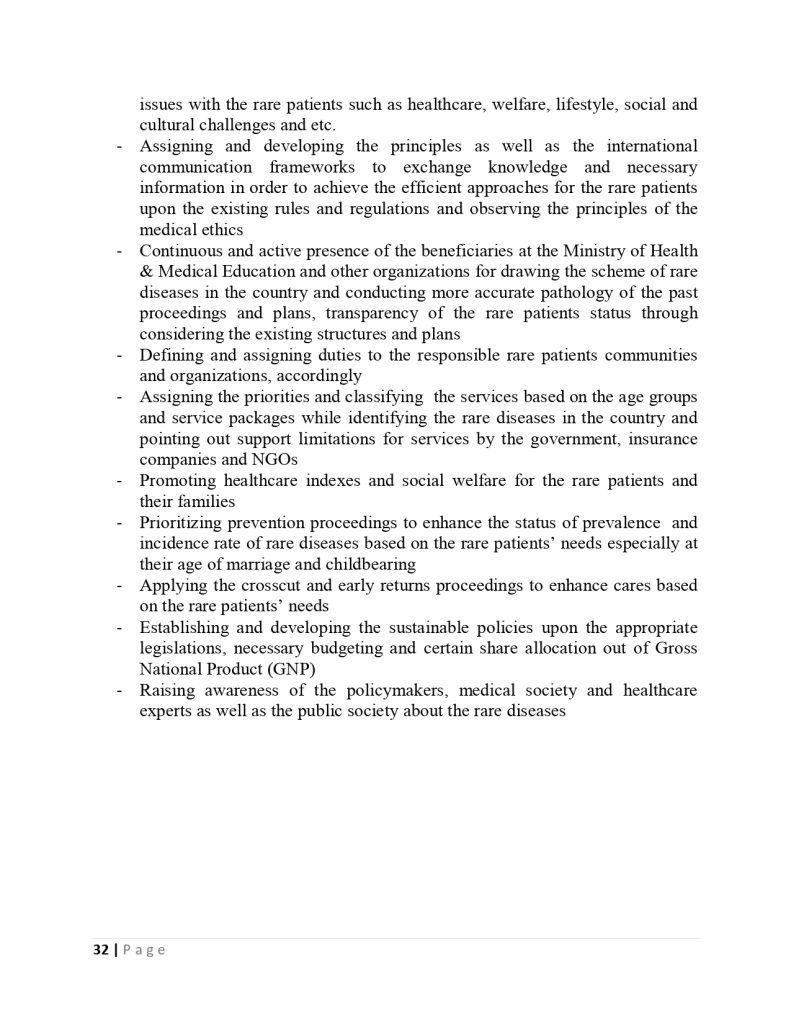
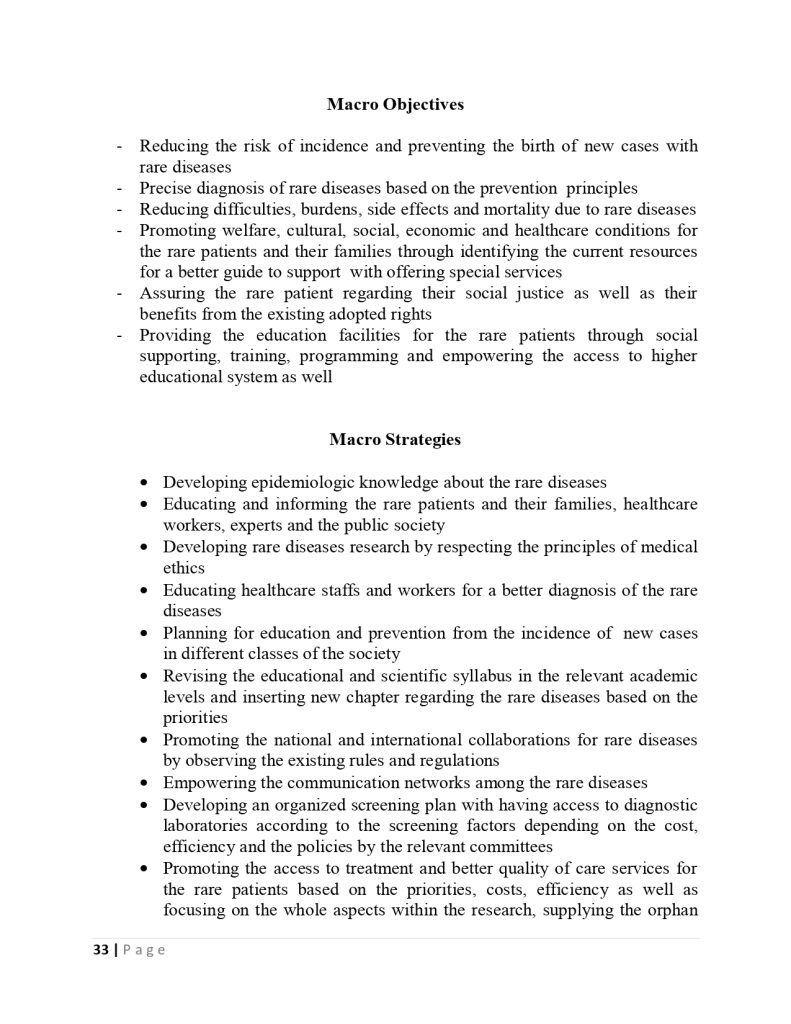
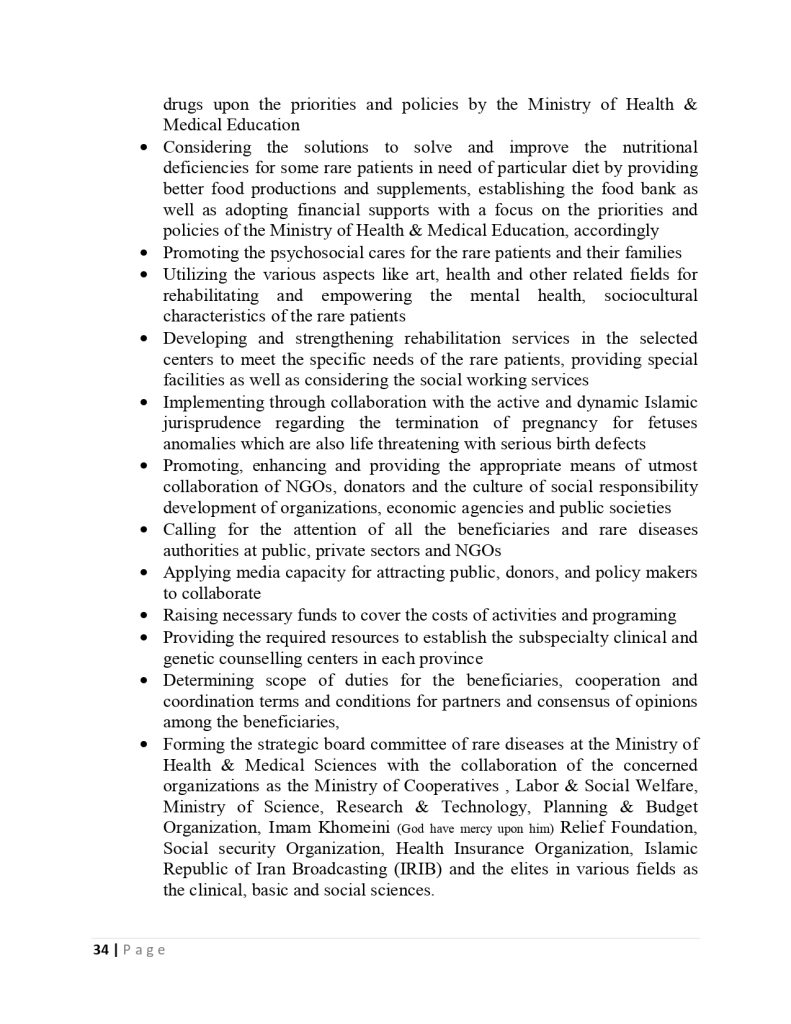
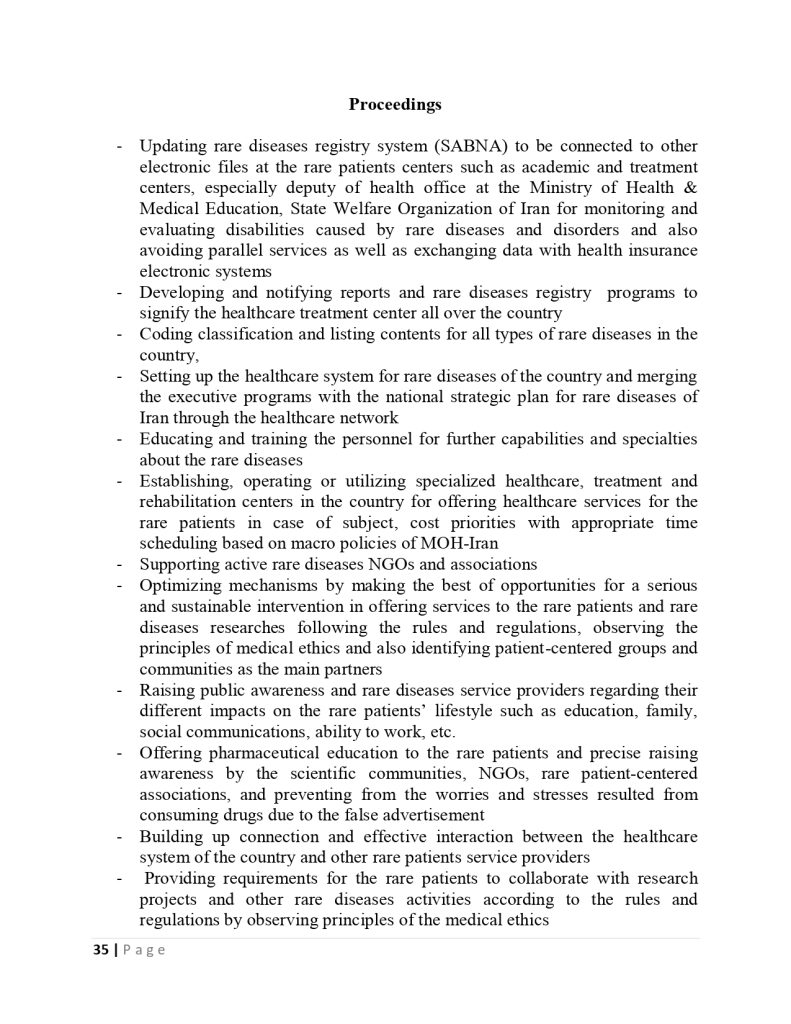
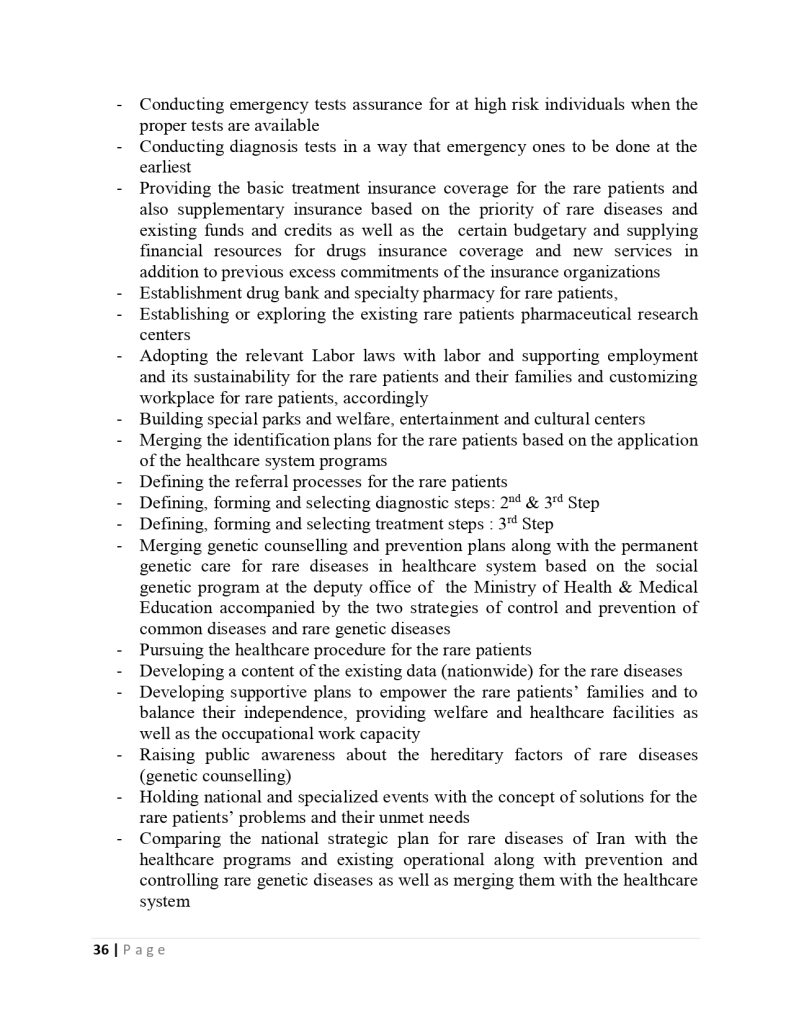
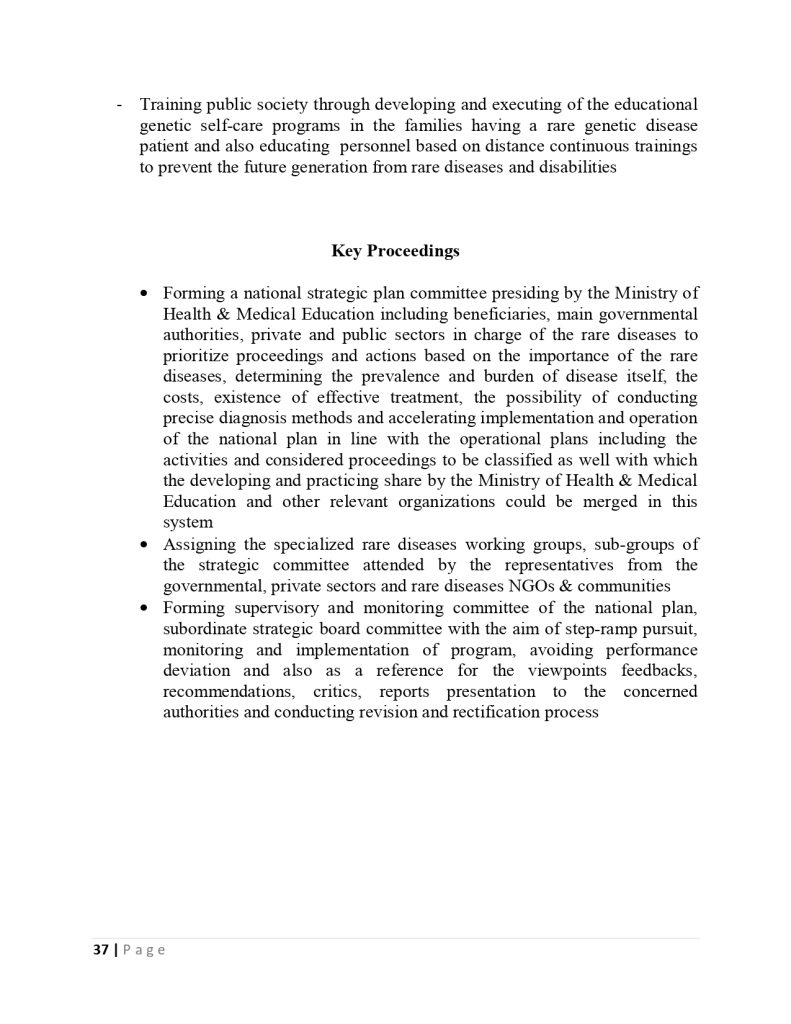
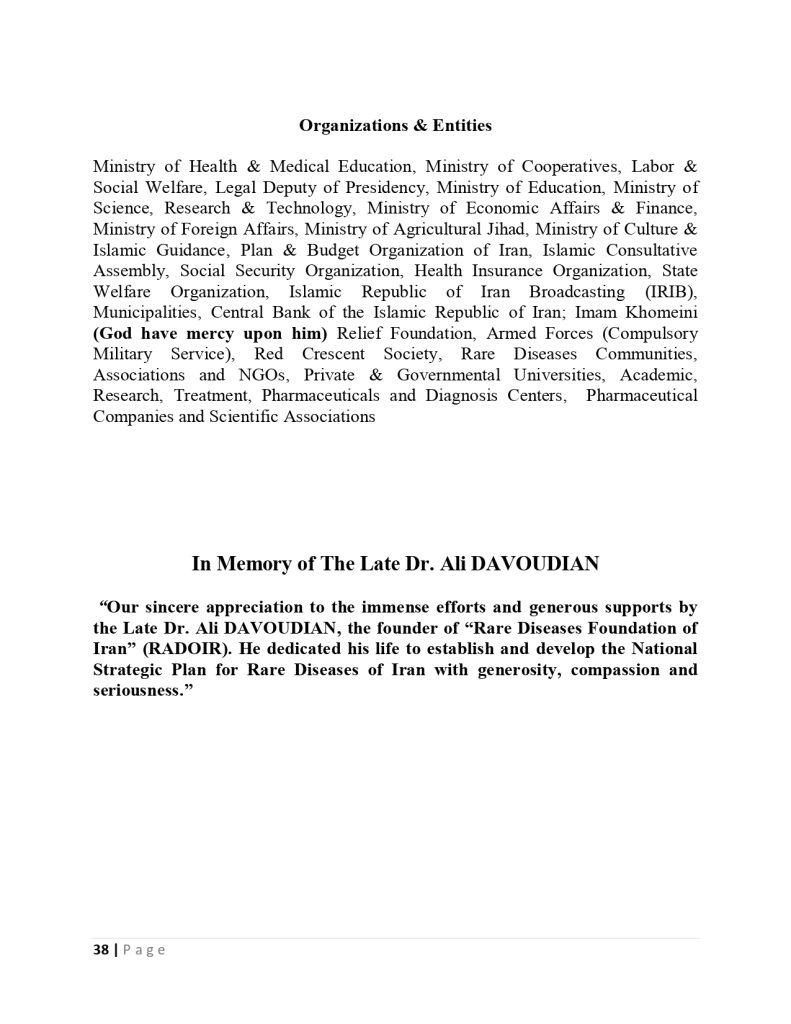

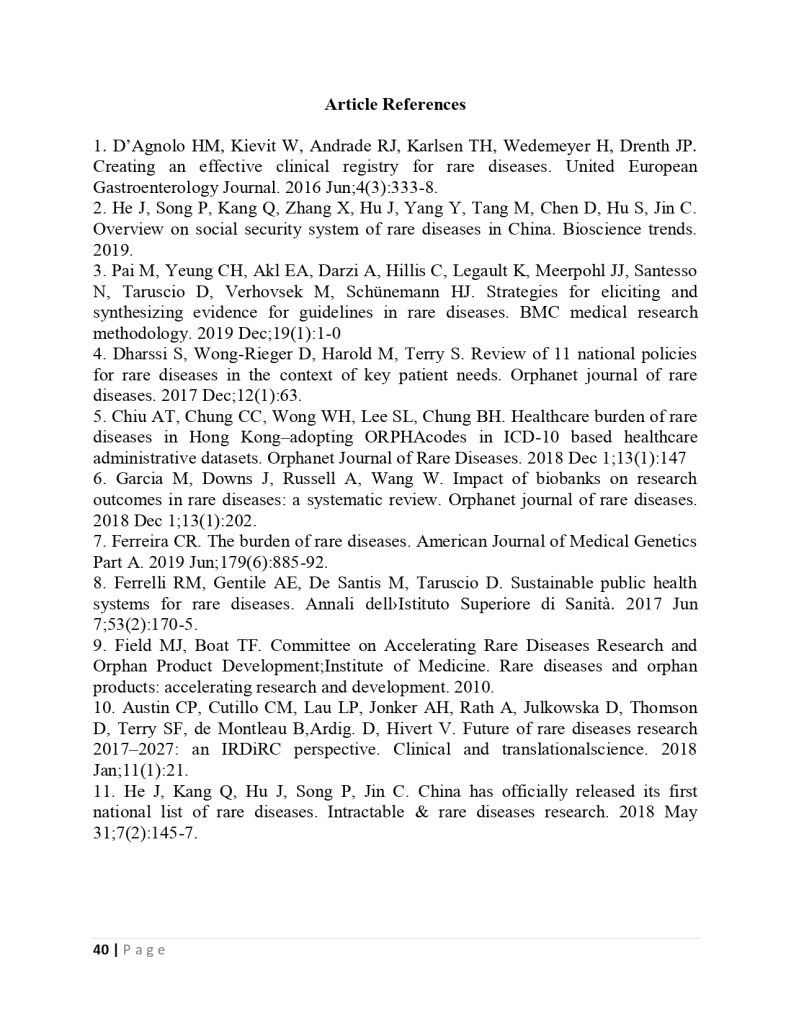
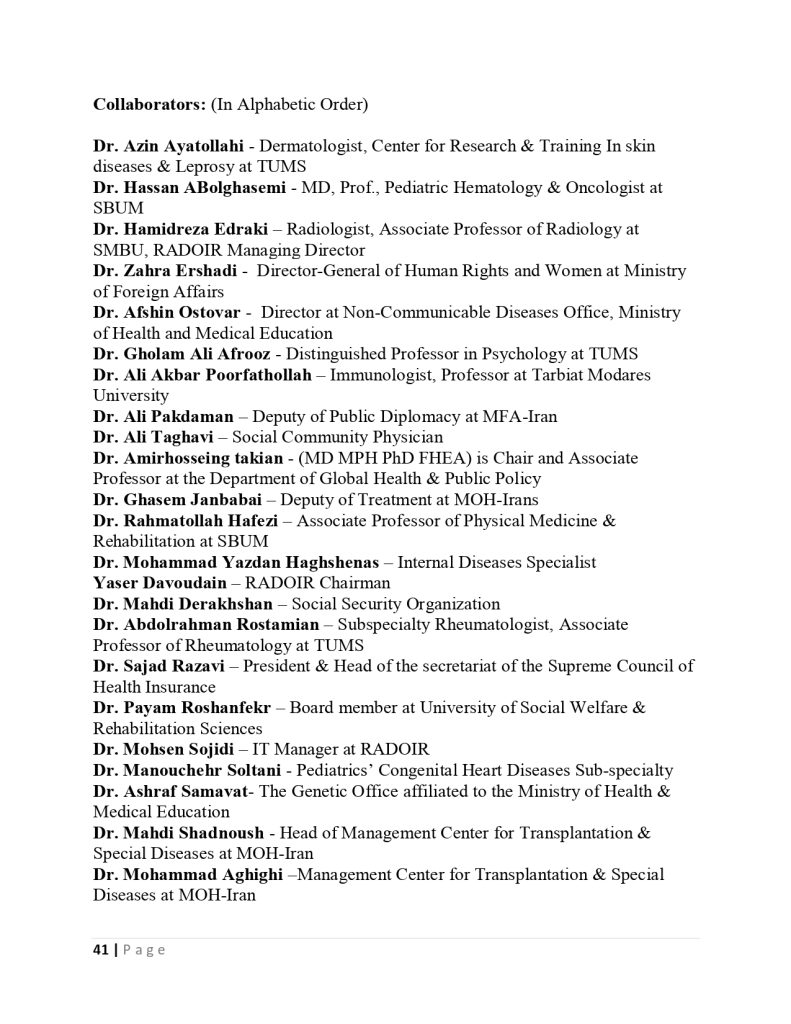
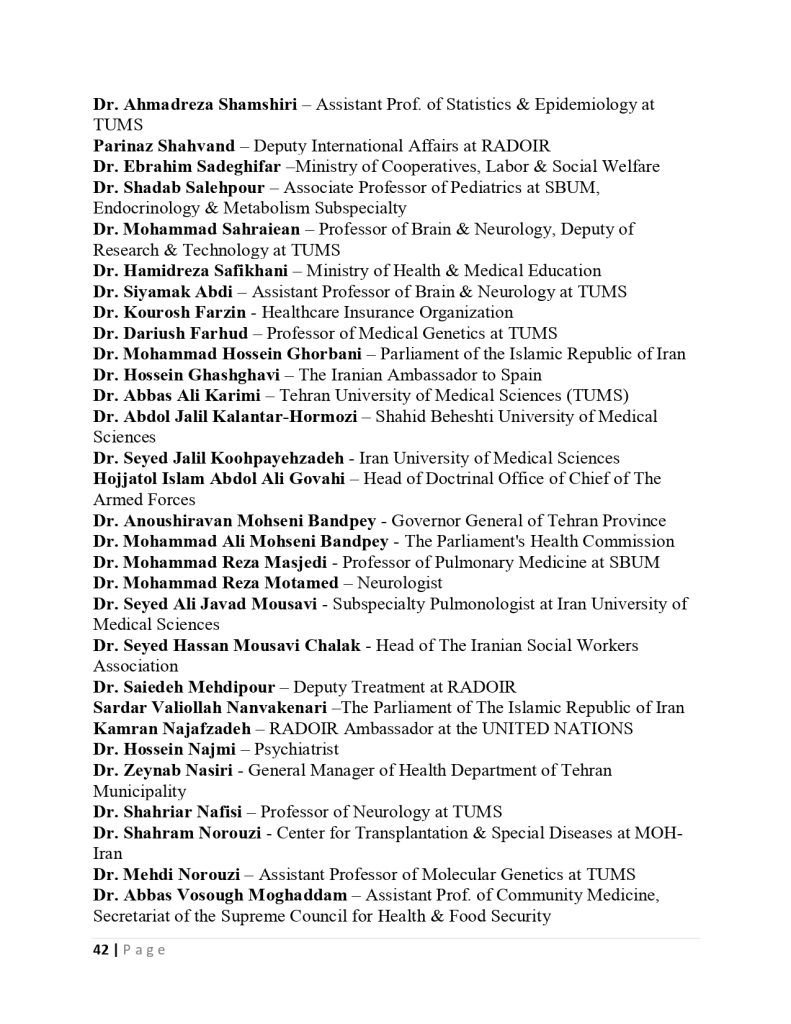
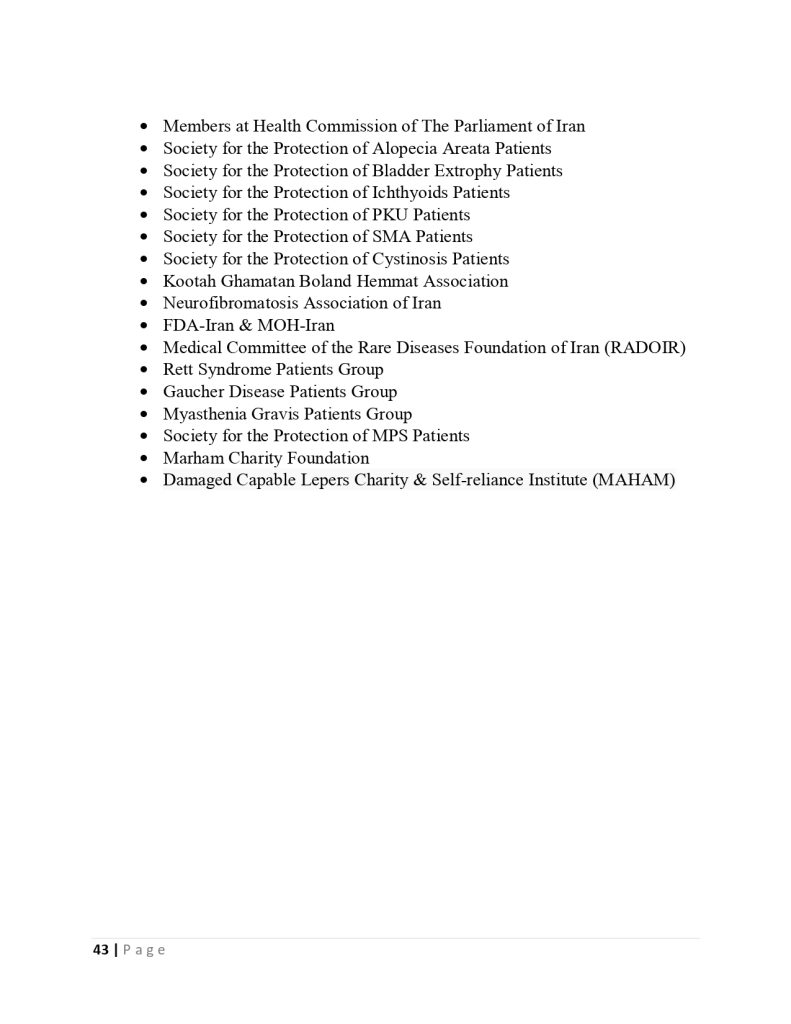
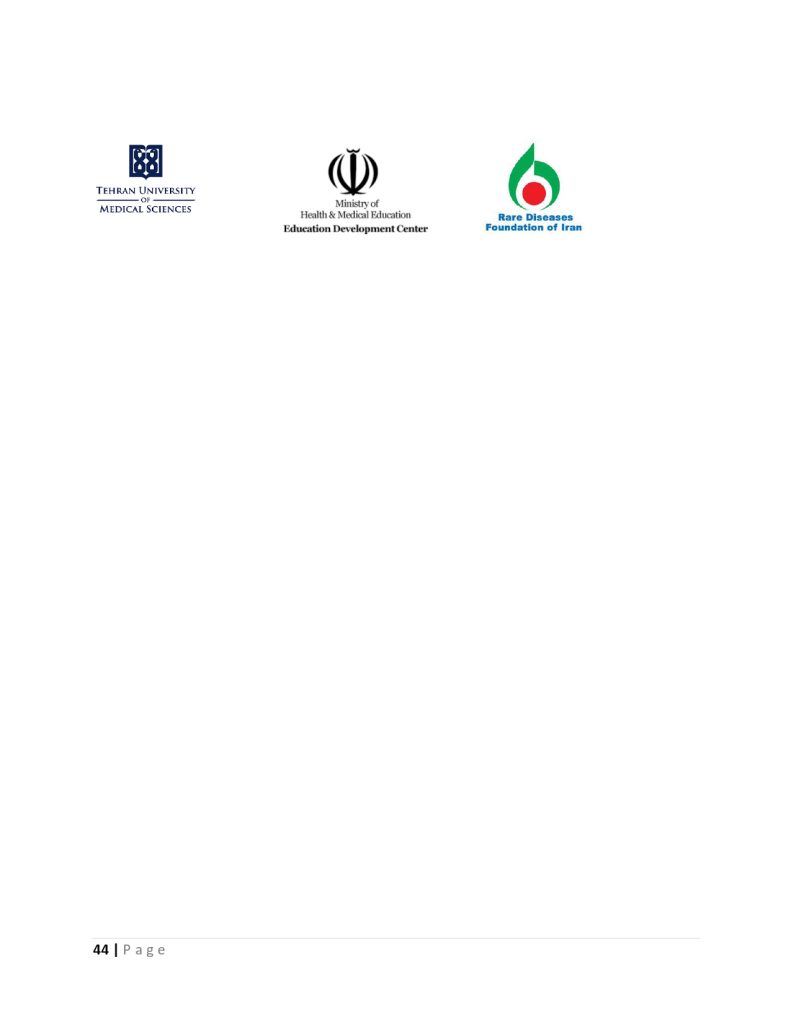
- 1
- 2










